On 10 September 1911 and at the age of 67 years, ‘Abdu’l-Bahá delivered the first public address of His life. From the pulpit of the City Temple in London, He announced to the reported 3,000-strong congregation: “This is a new cycle of human power.” Humanity’s dynamic acceleration toward greater levels of unity, He explained, was a consequence of the “light of Truth … shining upon the world.”1‘Abdu’l-Bahá in London. London: Bahá’í Publishing Trust, 1987, p.19.
Throughout the ensuing two years of His travels, ‘Abdu’l-Bahá—finally free after more than half a century of imprisonment and exile—continued to elucidate, in both open presentations and private conversations, the distinctive capacities of humanity in this “new day.”2‘Abdu’l-Bahá in London. London: Bahá’í Publishing Trust, 1987, p.19. In Paris, for example, He stated:
Look what man has accomplished in the field of science, consider his many discoveries and countless inventions and his profound understanding of natural law.
In the world of art it is just the same, and this wonderful development of man’s faculties becomes more and more rapid as time goes on. If the discoveries, inventions and material accomplishments of the last fifteen hundred years could be put together, you would see that there has been greater advancement during the last hundred years than in the previous fourteen centuries.3‘Abdu’l-Bahá. Paris Talks. Wilmette, Ill.: Bahá’í Publishing, 2006, p.84.
By the early years of the twentieth century, such advances were familiar in the Western societies into which ‘Abdu’l-Bahá ventured, which had been impacted by the scientific challenge to Bible-centric worldviews, technological progress and urbanization, shifts in governance and global consciousness, the intensification of financial exchange and improvements to the status of women. These and numerous other advancements—also taken up in distant corners of the planet, many of which had been annexed, colonized and influenced by Imperialist powers—are often included in the humanities and social sciences as some of the characteristics of “modernity.”
Concurrently, a wide variety of beliefs and practices later labelled ‘modernist’ were taking root. Ideals of truth, reason, and liberty were shared through diverse branches of human thought and endeavor, ranging from the materialistic to the esoteric. For the purposes of this exploration pertaining particularly to cultural pursuits, ‘modernism’ might be seen as both an outcome and, at times, a rejection of aspects of modernity. Rebelling against widely accepted norms, modernists in the arts set out to shun tradition and break rules, or at least push them to their limits. Painters dismissed the accurate depiction of reality, exploring instead the expressive and space-defining potential of color, experimented with abstracted forms, and revealed their process in the creation of an image; composers tested novel approaches to melody, harmony and rhythm; dancers drew upon the gestures of daily life or looked back to ancient civilizations for physical movements that stretched the possibilities of bodily expression; writers and dramatists departed from the established rules of prose, poetry, and playwriting to articulate the new sensibilities of the time. Some modernists conceived of utopian visions of society, albeit in certain cases by spreading the supremacy of their own nationalistic cultural heritage over neighboring traditions. At the heart of all of this burgeoning experimentation, however, was an aspiration for change, to which the subjective ‘self’ of the practitioner was central.
Ironically, while modernists often scorned uniformity and the imposition of Western values on the earth’s populations, they also turned for inspiration to the very cultures that were then becoming even more familiar to the public as a result of the expansionist ambitions of the powers under which they lived. A new universal art, some modernists believed, would emerge as they opened their eyes to what they considered to be the exciting, radical, and inventive qualities of the folk art and tribal crafts of the colonies, on display in museums and great expositions. Often it was the enormous wealth—extracted from colonialized subjects abroad and exploited lower classes at home—that enabled modernist projects, pursuits, and indulgences in the West.
Since the mid-nineteenth century, when Charles Darwin’s theory of evolution began to mount its challenge to the Biblical, anthropocentric conception of creation, the search for “an exotic and syncretic world religion” also became “an early modernist aim.”4Bernard Smith. Modernism and Post-Modernism, a neo-Colonial Viewpoint. Working Papers in Australian Studies, Sir Robert Menzies Centre for Australian Studies, Institute of Commonwealth Studies, University of London, 1992 New translations made accessible such religious texts as The Upanishads, The Bhagavad-Gita, and the Tao Te Ching. Elements of the religions of India and Tibet—and the more mystical strands of Judaism, Christianity, and Islam—were incorporated into modernist thinking, often through the teachings of the Theosophical Society, and especially among women seeking a spirituality that cut out the literal middle man.
Such was the burgeoning cultural landscape in the West when ‘Abdu’l-Bahá arrived with His message of the dawning of a new era in human evolution, in which the unity and equality of all humanity would be recognized and conflict and contention would give way to an enduring peace.
‘Abdu’l-Bahá’s discourse on progress was rooted in the conviction that the discoveries and developments of the age represented an instinctive response on the part of humanity to a new infusion of divine power into creation. Fundamental to the Bahá’í conception of history is the belief that, when a Manifestation of God appears in the world, the accompanying forces required to accomplish His divinely-ordained purpose are also released, setting in motion irresistible processes of societal transformation. Bahá’u’lláh proclaimed:
The world’s equilibrium hath been upset through the vibrating influence of this most great, this new World Order. Mankind’s ordered life hath been revolutionized through the agency of this unique, this wondrous System—the like of which mortal eyes have never witnessed.5Bahá’u’lláh. Gleanings from the Writings of Bahá’u’lláh. London: Bahá’í Publishing Trust, 1978, LXX, p.135.
The spiritual forces released by the Revelations of the Báb and Bahá’u’lláh were thus breaking down barriers and pushing an unknowing humanity toward the consciousness and realisation of its essential oneness, regardless of race, gender, class, or other divisive factors. Such forces had deranged the stability of the existing world order and instigated transformation at every level:
Through that Word the realities of all created things were shaken, were divided, separated, scattered, combined and reunited, disclosing, in both the contingent world and the heavenly kingdom, entities of a new creation …6Bahá’u’lláh. Gleanings from the Writings of Bahá’u’lláh. London: Bahá’í Publishing Trust, 1978, LXX, p.135.
These “spiritual, revolutionary forces,” observed ‘Abdu’l-Bahá’s grandson Shoghi Effendi, Guardian of the Bahá’í Faith, “… are upsetting the equilibrium, and throwing into such confusion, the ancient institutions of mankind.”7Shoghi Effendi. The Promised Day is Come. Wilmette, Ill.: Bahá’í Publishing Trust, 1980, p.95 Humanity, either in its overt resistance to—or in its attempts to stimulate—social transformation was, in Shoghi Effendi’s analysis, experiencing the “commotions invariably associated with the most turbulent stage of its evolution, the stage of adolescence, when the impetuosity of youth and its vehemence reach their climax …”8Shoghi Effendi. ‘The Unfoldment of World Civilization’, The World Order of Bahá’u’lláh. Wilmette, Ill.: Bahá’í Publishing Trust, 1991, p.202 While the internal physiological processes within an individual trigger the onset of adolescence, the release into the world of Divine Revelation affects the inner fibre of human life and thought, and has an impact far beyond the personal orbit of a Manifestation of God and those who physically hear His message or respond directly to His call. It suffuses every aspect of existence and at a subliminal level is received by sensitive human hearts and minds, as yet oblivious to its source.
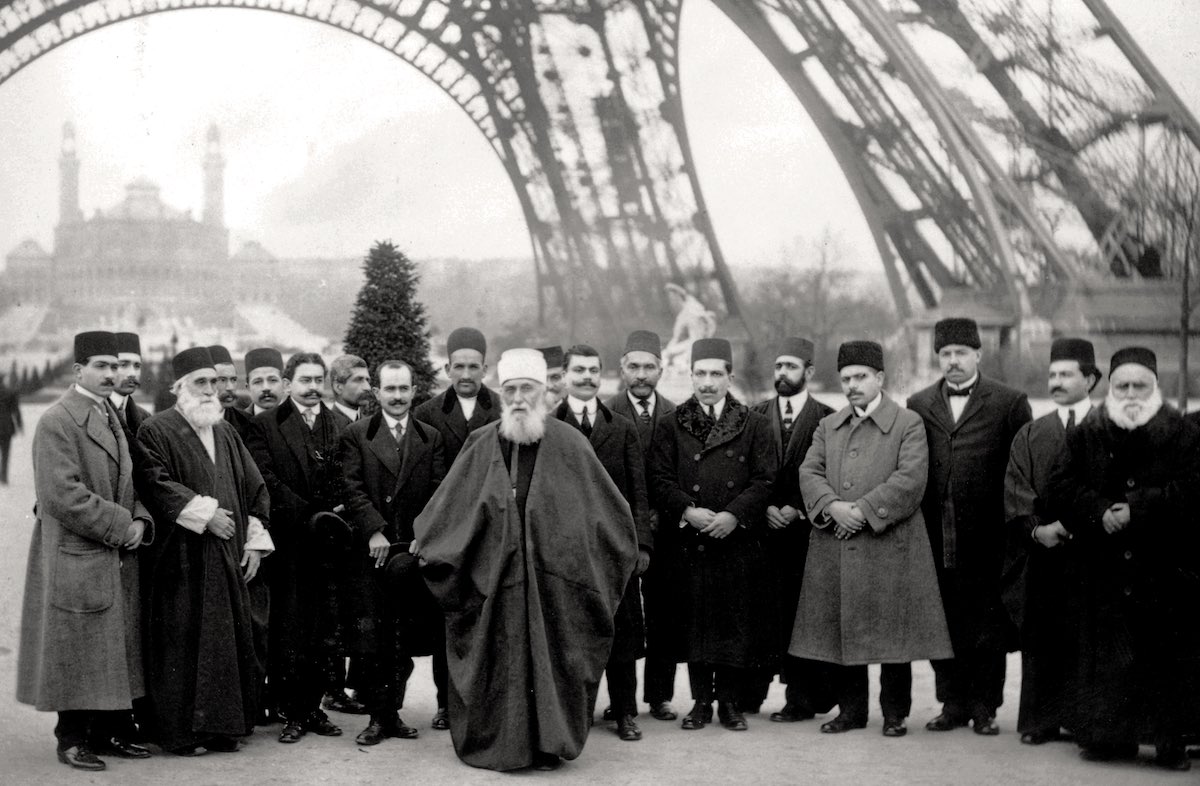
At the time of ‘Abdu’l-Bahá’s arrival in Paris on 3 October 1911, the French capital was maintaining its status as the most fertile arena for artists, writers, and musicians—including countless Americans—engaged in a passionate quest to live and work free from stifling convention. “I like Paris because I find something here, something of integrity, which I seem to have strangely lost in my own country,” wrote the African-American writer Jessie Redmon Fauset. “It is simplest of all to say that I like to live among people and surroundings where I am not always conscious of ‘thou shall not.’”9Shari Benstock. Women of the Left Bank: Paris, 1900-1940. London: Virago, 1986, p.13 For women such as Fauset, who were escaping their homeland, where even educated Black citizens were still prohibited from participating in most social spaces, Paris offered the opportunity for fearless experimentation and acceptance. It was a city in which scientists such as the Polish Nobel Prize-winning physicist and chemist Marie Curie could train and embark on their careers, and where literary salons—including those hosted by expatriates Gertrude Stein and Natalie Clifford Barney—flourished, offering spaces where artists and writers could uninhibitedly share their ideas and work.
Women had also played a significant role in the establishment, in Paris, of the first Bahá’í centre in Europe at the close of the nineteenth century. Through the efforts of May Ellis Bolles (later Maxwell), many important figures in early Western Bahá’í history embraced the message of Bahá’u’lláh in the city. Among them were other Americans and Canadians, including painters such as Juliet Thompson and Marion Jack, and heiress Laura Clifford-Barney, Natalie’s sister. Impressionist painter Frank Edwin Scott, architect William Sutherland Maxwell, poet and art gallery manager Horace Holley and the Irish-born philanthropist Lady Blomfield also first came across the Bahá’í teachings in Paris. Experimental dancer Raymond Duncan, brother of the more renowned Isadora, and composer Dane Rudhyar were included in the Bahá’í circle. Rudhyar was a modernist who intuitively felt that Western civilization was coming to “the autumn phase of its cycle of existence.”10Rudhyar Archival Project. http://www.khaldea.com/rudhyar/bio1.shtml Later composing Commune—based on the words of ‘Abdu’l-Bahá— Rudhyar deemed the Bahá’í message to have embodied “clearly the most basic keynotes of the collective spirit of the age …”11Dane Rhudyar, cited in The Bahá’í World Vol. XIII 1954-1963. Haifa: The Universal House of Justice, 1970, p.829
To exhausted communities of the world [the Bahá’í Revelation] gives vital impetus which, we hope, will soon energize new creative manifestations and produce an inspired art, equal or superior to that of early Christianity.12Dane Rhudyar, cited in The Bahá’í World Vol. XIII 1954-1963. Haifa: The Universal House of Justice, 1970, p.829.
Many artists and writers of the period were continuing to take a Symbolist approach. As a prelude to more far-reaching forms of abstraction, Symbolists strove to represent universal truths through metaphorical language and imagery, in an attempt to “illumine the deepest contradictions of contemporary culture seen through the prism of various cultures.”13Andrei Bely. The Emblematics of Meaning: Premises to a Theory of Symbolism, 1909 The novelist Andrei Bely wrote:
… we are now experiencing, as it were, the whole of the past: India, Persia, Egypt, Greece … pass before us … just as a man on the point of death may see the whole of his life in an instant … An important hour has struck for humanity. We are indeed attempting something new but the old has to be taken into account …14Andrei Bely. The Emblematics of Meaning: Premises to a Theory of Symbolism, 1909
It seems natural, then, that the opportunity to see in person a striking, venerable figure from Persia was intriguing to those who sought enlightenment from the East to find a language appropriate for expressing the modern world. The influential critic and Symbolist poet Remy de Gourmont, for example, met ‘Abdu’l-Bahá in Paris on 20 October 1911. From Gourmont’s account, published in La France, ‘Abdu’l-Bahá appears to have been alert to the fact that he was a writer for whom a metaphorical depiction of spiritual reality would have appeal:
… The eloquent patriarch spoke to us of the simple joys experienced in the Bahá’í city, of pleasures designed to delight the docile hearts, where spring is eternal, ever-flowering with the perpetual blooming of lilies, violets and roses, where women smile and men are happy in the perfume air of love. And we spoke of the great truth that excels all the previous truths, in which our little human errors are melted and transformed, as such quarrels disappear in the shade of the greatest Peace. And we felt a deep passion in the faintly halting voice, roughly punctuated by the guttural sounds of the Persian language, but also gently punctuated by the phrasing of his musical laughter. For the prophet is joyful and we all feel within him the gaiety of being a prophet, upon whom forty years of prison have left no trace. He had with him a bouquet of violets, offering one to each of his visitors; to the most resistant to his teachings and to those who had the audacity to stubbornly oppose him, the parma violets serve as his arguments, as do his hearty laugh, his beautiful and poetic arguments, and the simplicity of his Persian dress.15 See Amin Egea. The Apostle of Peace Vol.1: 1871-1912. Oxford: George Ronald Publisher, 2017, p.164.
Evidently touched by their exchange, Gourmont urged his readers to seek out ‘Abdu’l-Bahá’s public appearances. Subsequently, using a pseudonym, Gourmont even penned a review of his own La France article for another journal.
Another significant modernist who learned of ‘Abdu’l-Bahá was Guillaume Apollinaire, although whether they met is not known. One of the foremost poets of the early twentieth century and a close associate of such emerging painters as Picasso, Braque, and Marie Laurencin, Apollinaire is credited with coining the terms “Cubism” in 1911 and “Surrealism” in 1917. His “Le Béhaisme” appeared in the Mercure de France on 17 October 1917. That article concludes:
A new voice is coming out of Asia. Already many in Europe believe that the word of Beha-Oullah[sic] does not contradict our modern science and can be assimilated for we[sic] Europeans, who need comforting. Isn’t it just that this comfort comes to us from Asia as it came before?16Guillaume Apollinaire, “Le Béhaisme.” Mercure de France, 16 October 1917, p.768
In like manner, ‘Abdu’l-Bahá’s stay in London was widely reported in the publications of the day. One weekly magazine, aptly titled The New Age and supported by the future Nobel Prize-winning writer George Bernard Shaw, was dedicated to publishing modernism in literature and the arts. In its 21 September 1911 edition, two weeks after ‘Abdu’l-Bahá’s arrival in the city, The New Age reported, “Seeds of strange religions are wafted from time to time on our shores. But fortunately or unfortunately, they do not find the soil in us in which to flourish … The latest to land in public is Bahaism, of which, indeed many of us have heard in private these many years.”17A.R. Orage. “Notes of the Week.” New Age 9, September 1911, p.484
The pioneering modernist poet Ezra Pound was a regular contributor to The New Age. The day after “Bahaism” was mentioned in its pages, Pound stated somewhat arrogantly to his future wife, Dorothy Shakespear, “They tell me I’m likely to meet the Bahi[sic] next week in order to find out whether I know more about heaven than he does …’18Ezra Pound, cited in Elham Afnan, “‘Abdu’l-Bahá and Ezra Pound’s Circle”, The Journal of Bahá’í Studies Volume 6 No.2, June-September 1994, p.8 Following their meeting, Pound then wrote to Margaret Cravens, a friend who lived in the French capital, “I met the Bahi yesterday, he is a dear old man. I wonder would you like to meet him, he goes to Paris next week. I’ll arrange for you anyhow and you can go or not, as you like.”19Omar Pound and Robert Spoo, editors. Ezra Pound and Margaret Cravens: A Tragic Friendship 1910-1912. Durham: Duke University Press, 1988, p.90. In a further communication to Cravens, Pound was clearly eager for his friend to see ‘Abdu’l-Bahá, placing His significance above that of the French post-Impressionist painter Paul Cézanne:
The Bahi—Abdul Baha, Abbas Effendi, or whatever you like to call him is at the Dreyfus Barney’s … and any one interested in the movement can write and see him there by appointment. It’s more important than Cezanne, & not in the least like what you’d expect of an oriental religious now. At least, I went to conduct an inquisition & came away feeling that questions would have been an impertinence. The whole point is that they have done instead of talking …20Omar Pound and Robert Spoo, editors. Ezra Pound and Margaret Cravens: A Tragic Friendship 1910-1912. Durham: Duke University Press, 1988, p.95.
Despite Pound’s later, well-documented inclination towards fascism—which is about as ideologically far removed as can be imagined from ‘Abdu’l-Bahá’s purpose—it nevertheless appears that he was momentarily disarmed by ‘Abdu’l-Bahá. The poet even revived his memory of that day more than two decades later in his monumental verse cycle The Cantos. “Pound did not interest himself in ‘Abdu’l-Bahá’s message beyond expressing approval of its unexpected modernity,” literature scholar Elham Afnan has observed, yet the “portrait of ‘Abdu’l-Bahá [in Canto XLVI], despite its flippancy, is basically sympathetic and as respectful as Pound can manage to be.”21Elham Afnan, “Abdu’l-Bahá and Ezra Pound’s Circle”, p.11.
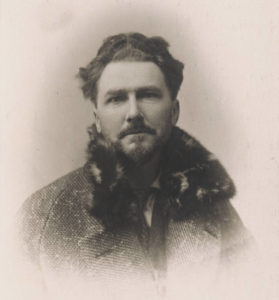
Pound was also a contributor to the modernist journal Blast, in which ‘Abdu’l-Bahá’s name appeared in a somewhat surprising fashion. Blast was the creation of the painter and novelist Percy Wyndham Lewis, founder of the short-lived Vorticist movement, which was inspired by the Cubism of Picasso and Braque, and the Italian Futurists’ celebration of the machine age. The first edition of Blast contained an extensive list of people, institutions, and objects that were, in the Vorticist view, either “Blessed” or “Blasted.” Curiously, included among those “Blasted” is the name “Abdul Bahai.” Since there is no record of Wyndham Lewis having met ‘Abdu’l-Bahá, the inclusion of His name in such a provocative list is perhaps more indicative of the contempt in which Blast’s editors held organized religion, or anything they deemed “bourgeois” and “establishment,” which may have encompassed the involvement of wealthy Londoners in Eastern movements.
In time, ‘Abdu’l-Bahá’s fame reached and impacted modernists much farther afield than the cities in which He spoke. In August 1911, the influential Japanese writer Yone Noguchi had sent Ezra Pound two books of his poems. Pound was very taken with Noguchi’s work, saying, “If east and west are ever to understand each other that understanding must come slowly and come first through art.”22Cited in Howard J.Booth and Nigel Rigby, Modernism and Empire. Manchester: Manchester University Press, 2000, p.82.
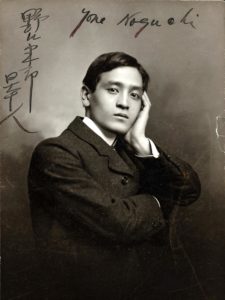
Noguchi later learned of ‘Abdu’l-Bahá from Agnes Alexander, a Hawaiian-born Bahá’í who had been sent by Him to share the Bahá’í Teachings in Japan.23Agnes Baldwin Alexander, History of the Bahá’í Faith in Japan 1914-1938. Tokyo: Bahá’í Publishing Trust, 1977, p.41. Noguchi wrote:
I have heard so much about ‘Abdu’l-Bahá, whom people call an idealist, but I should like to call Him a realist, because no idealism, when it is strong and true, exists without the endorsement of realism. There is nothing more real than His words on truth. His words are as simple as the sunlight; again like the sunlight, they are universal. … No Teacher, I think, is more important today than ‘Abdu’l-Bahá.24Yone Noguchi, cited in The Bahá’í World Vol. VIII 1938-1940. Wilmette, Ill.: Bahá’í Publishing Trust, 1981, p.624.
During the early days of the First World War, Agnes Alexander also introduced the Bahá’í Faith to the highly influential English potter Bernard Leach, who recalled: “We asked what had brought her to Japan and I was struck by the quietness of her smile when she answered ‘… you will not understand, but I came because a little old Persian Gentleman asked me to come.’”25Bernard Leach, “My Religious Faith” in Robert Weinberg, ed., Spinning the Clay into Stars. Oxford: George Ronald Publisher, 1999, p.60. Leach—who became the most significant figure in the revival of craft pottery in modern Britain—dedicated his entire life to encouraging the union of East and West, fully embracing the Bahá’í Faith in 1940 after he was re-introduced to it by the American painter Mark Tobey, when they were both teaching at the progressive arts school Dartington Hall in Devon, England.
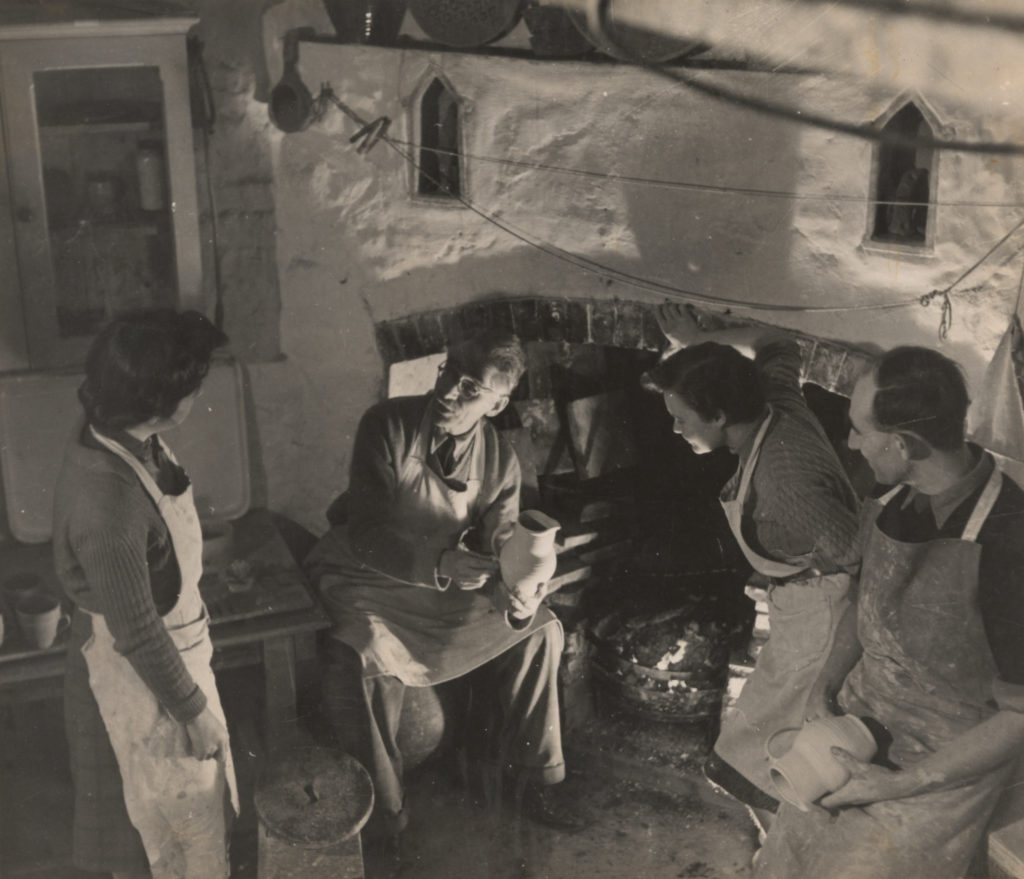
Also favorable in his response to ‘Abdu’l-Bahá was another enthusiast for modernism, Professor Michael Sadler. A progressive educationalist and university administrator, Sadler was president of the Leeds Arts Club, which mixed socialist and anarchist politics with the philosophy of Nietzsche, suffragette feminism, Theosophy, avant-garde art, and poetry. Sadler built up a remarkable collection of art, including a Symbolist masterpiece by Paul Gauguin and works by the Russian Expressionist painter Wassily Kandinsky, at a time when his paintings were either unknown or dismissed in London, even by well-known supporters of modernism. In Kandinsky’s seminal 1911 treatise, Über das Geistige in der Kunst (Concerning the Spiritual in Art), translated into English by Sadler’s son, the painter proposed that abstraction in painting was the best weapon for transforming a corrupt, materialist society.
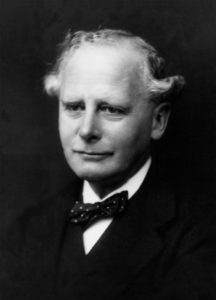
Michael Sadler presided over ‘Abdu’l-Bahá’s farewell talk at the conclusion of His first visit to London, on 29 September 1911, saying:
We have met together to bid farewell to ‘Abdu’l-Bahá, and to thank God for his example and teaching, and for the power of his prayers to bring Light into confused thought, Hope into the place of dread, Faith where doubt was, and into troubled hearts, the Love which overmasters self-seeking and fear.
Though we all, among ourselves, in our devotional allegiance have our own individual loyalties, to all of us ‘Abdu’l-Bahá brings, and has brought, a message of Unity, of sympathy and of Peace. He bids us all be real and true in what we profess to believe; and to treasure above everything the Spirit behind the form. With him we bow before the Hidden Name, before that which is of every life the Inner Life! He bids us worship in fearless loyalty to our own faith, but with ever stronger yearning after Union, Brotherhood, and Love; so turning ourselves in Spirit, and with our whole heart, that we may enter more into the mind of God, which is above class, above race, and beyond time.26‘Abdu’l-Bahá in London. London: Bahá’í Publishing Trust, 1987, p.34.
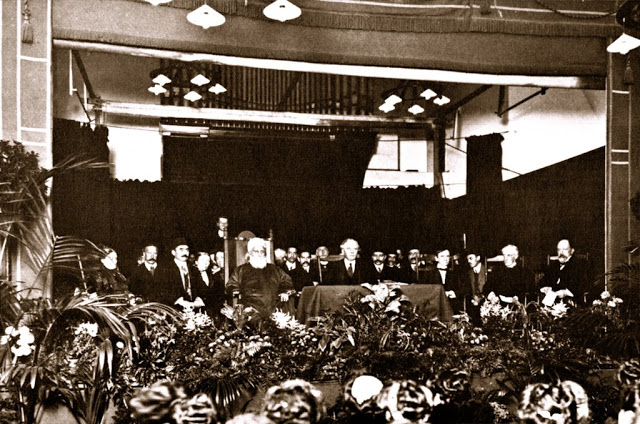
In January 1913, when ‘Abdu’l-Bahá travelled to Edinburgh, Scotland’s main proponents of modernist painting—known as the Scottish Colourists—were working abroad in France, where their pictures were exhibited and sold predominately by the Paris gallery managed by Horace Holley. Symbolism, however, was a strong component of the Celtic Revival movement, in which artists and writers drew inspiration from the ancient myths and traditions of Gaelic literature and the early British mediaeval style to create art in a modern idiom. While in Edinburgh, ‘Abdu’l-Bahá spoke with a number of artists through introductions from leading Celtic Revivalist Sir Patrick Geddes, the celebrated philanthropist and town planner (who also had the dubious honor of being “blasted” by Wyndham Lewis). Geddes presided over a public gathering with ‘Abdu’l-Bahá, saying of Him:
We approve of the ideal He lays before us of education and the necessity of each one learning a trade, and His beautiful simile of the two wings on which society is to rise into a purer and clearer atmosphere, put into beautiful words what was in the minds of many of us. What impressed us most is that courage which enabled Him, during long years of imprisonment, and even in the face of death, to hold fast to His convictions.27H.M. Balyuzi. ‘Abdu’l-Bahá: The Centre of the Covenant. Oxford: George Ronald Publisher, 1971, p.365.
Geddes invited ‘Abdu’l-Bahá to visit a protégé of his, the painter John Duncan and Duncan’s wife Christine who had connections to ‘Abdu’l-Bahá’s friends Wellesley Tudor Pole and Alice Buckton, who shared in her Spiritualist interests. Among Duncan’s paintings, ‘Abdu’l-Bahá viewed St. Bride—now housed in the Scottish National Gallery of Modern Art—depicting the Irish saint who, legend has it, was transported by angels from Ireland to Bethlehem to attend the birth of Christ. ‘Abdu’l-Bahá reportedly blessed the paintings, much to the delight of the Duncans.
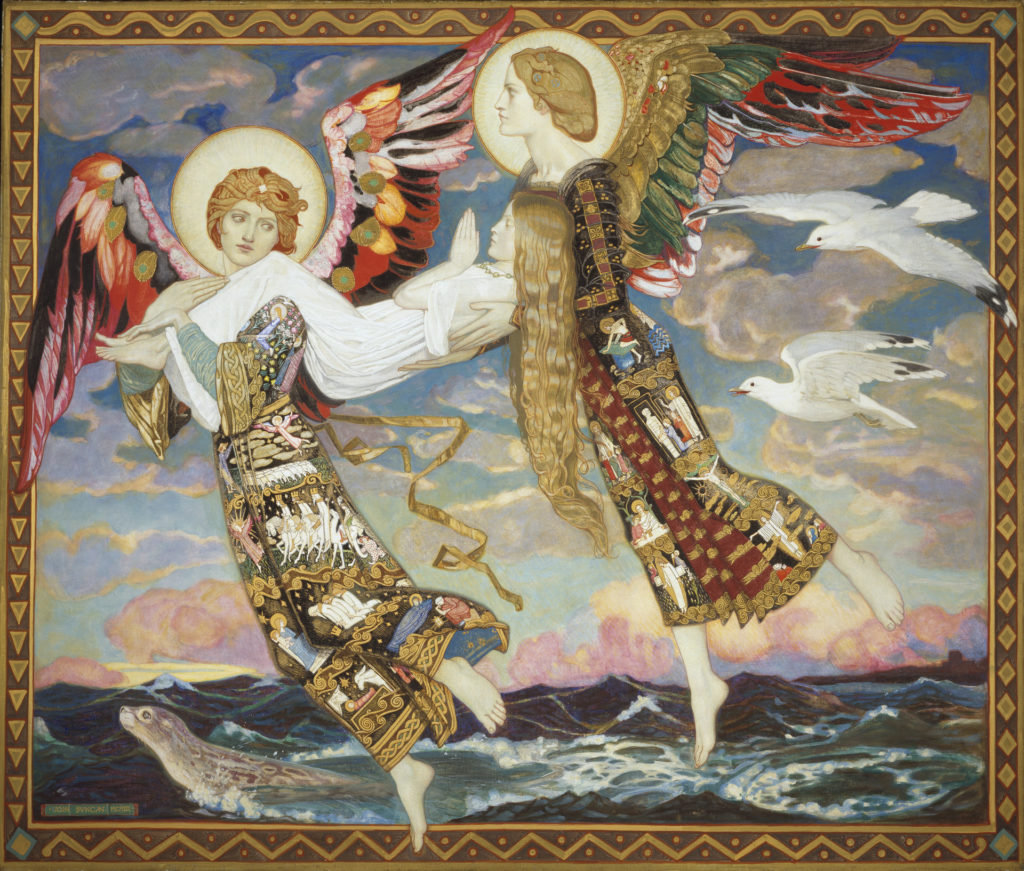
At the Edinburgh College of Arts, ‘Abdu’l-Bahá also encouraged a prize-winning sculptor, Fanindra Nath Bose, from Calcutta. ‘Abdu’l-Bahá praised Bose’s work, suggesting he return to India to found a new school of sculpture.28H.M. Balyuzi. ‘Abdu’l-Bahá: The Centre of the Covenant. Oxford: George Ronald Publisher, 1971, p.11. Later in 1913, Bose relocated to Paris to work under the great sculptor Auguste Rodin, which led to his becoming part of the “new sculpture” movement in Britain, creating small, figurative, Symbolist statues.
In addition to conversing with artists, ‘Abdu’l-Bahá occasionally agreed to have His portrait painted. During the nine days in April 1913 that He stayed in Budapest, Hungary, He sat three times for Róbert Nádler, a celebrated painter and teacher at the Academy of Fine Arts and president of the city’s Theosophical Society. Two decades later, Nádler warmly recalled the experience, saying, “I saw with admiration that in his facial expression peace, clean love, and perfect good intentions reflected themselves. He saw everything in such a beatific light; he found everything beautiful the outer life of the city, as well as the souls of its inhabitants.”29Cited in Martha Root, “‘Abdu’l-Bahá’s Visit to Budapest”, in Kay Zinky, ed., Martha Root: Herald of the Kingdom. New Delhi: Bahá’í Publishing Trust, 1983, pp.361-370 Nádler’s sympathetic painting of ‘Abdu’l-Bahá is unique among the portraits made of Him, taking an Impressionistic impasto approach, particularly in the treatment of ‘Abdu’l-Bahá’s gossamer-like beard, made up of rhythmic brushstrokes.
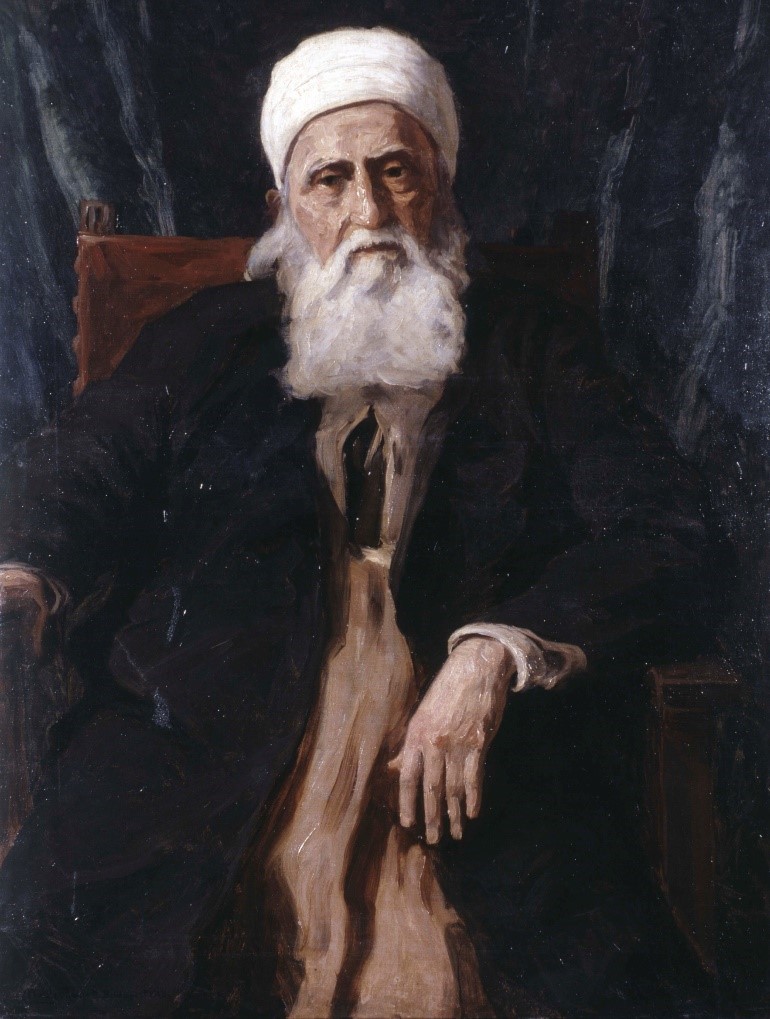
During ‘Abdu’l-Bahá’s nine-month sojourn in North America, the most well-known literary personality to encounter Him was the Syrian-born, Lebanese-American writer and artist Kahlil Gibran, a central figure of Arabic literary modernism. Gibran arrived in New York City at the end of April 1911, his creative horizons having expanded during his exposure to modernists in Paris. Greenwich Village, where Gibran settled, was a gathering place for radical political and bohemian thinkers who were committed to an imminent revolution in human consciousness and social change. Art, they believed, would provide people with new values, giving rise to a new social order. In 1913, modern European art arrived forcefully in New York, when astonished Americans saw for the first time more than 300 avant-garde works at the infamous Armory Show. While remaining unmoved by most of the pieces on display, Gibran was sensitive to the motivations of modern artists, saying, “… the spirit of the movement will never pass away, for it is real—as real as the human hunger for freedom.”30Jean Gibran and Kahlil Gibran. Kahlil Gibran: His Life and World. Edinburgh, Canongate Press, 1992, p.252
Gibran “simply adored” ‘Abdu’l-Bahá, recalled Juliet Thompson, who was Gibran’s neighbour. “He was with Him whenever he could be.”31Marzieh Gail, “Juliet Remembers Gibran”, Other People, Other Places. Oxford: George Ronald Publisher, p.230. On 19 April 1912, Gibran sketched a portrait for which ‘Abdu’l-Baha sat and, for the rest of his life, “often talked of Him, most sympathetically and most lovingly.”32Marzieh Gail, “Juliet Remembers Gibran”, Other People, Other Places. Oxford: George Ronald Publisher, p.230. ‘Abdu’l-Bahá may well have been a source of inspiration for Gibran’s most famous work, The Prophet. The name of the book’s main protagonist Almustafa, it has been posited, resembles that of ‘Abdu’l-Bahá with only the consonants changed,33See David Langness, ‘The Bahá’í influence on Kahlil Gibran’s The Prophet’. https://bahaiteachings.org/bahai-influence-on-kahlil-gibrans-the-prophet/ and the villagers in the narrative refer to him as ‘The Master,’ an appellation commonly used in relation to ‘Abdu’l-Bahá. While Thompson did not later recall there being any definite connection between The Prophet and Gibran’s meeting with ‘Abdu’l-Bahá, the author did tell her that when he was writing The Son of Man, “he thought of ‘Abdu’l-Bahá all through.”34Gail, Other People, Other Places, p.228 He also expressed his intention—though it was never realised—to write a book specifically about ‘Abdu’l-Bahá.
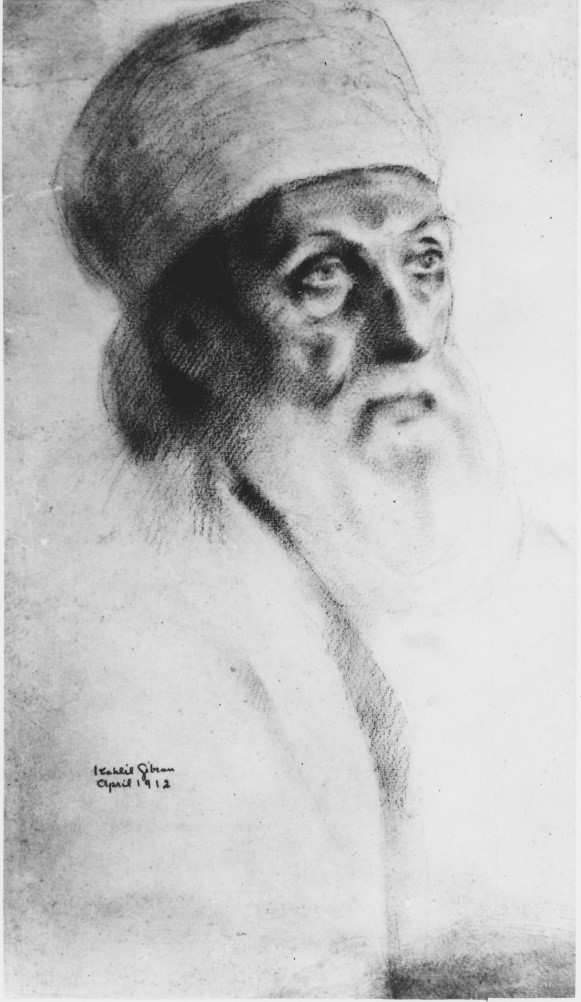
Juliet Thompson also arranged for ‘Abdu’l-Bahá to sit for the outstanding photographer Gertrude Käsebier. Since 1899, Alfred Stieglitz—a prominent New York gallery owner who championed American modernism—had promoted photography through his ‘Photo-Secession’ movement, which aimed to advance photography as a serious new art form and exhibit the finest work by American practitioners. Käsebier, who Stieglitz deemed to be the leading artistic portrait photographer of the day, was at the heart of Photo-Secession and believed the medium could be a particularly suitable art form and source of income for women. “I earnestly advise women of artistic tastes to train for the unworked field of modern photography,” she said in a lecture. “It seems to be especially adapted to them, and the few who have entered it are meeting a gratifying and profitable success.”35Cited in Stephen Petersen and Janis A. Tomlinson, eds. Gertrude Kasebier – The Complexity of Light and Shade. University of Delaware Press, 2013, p.11.
Käsebier had distinguished herself by her sympathetic, powerful portraits of America’s indigenous peoples, focusing on their expressions and individuality, rather than costumes and customs, a sensitivity she deployed in her portrait session with ‘Abdu’l-Bahá on 20 June 1912. “I shall never forget the Master’s beauty in the strange cold light of her studio,” wrote Thompson in her diary, “a green, underwater sort of light, in which He looked shining and chiselled, like the statue of a god. But the pictures are dark shadows of Him.”36Juliet Thompson. The Diary of Juliet Thompson. Los Angeles: Kalimát Press, 1983, p.317. Kasebier, though, told Thompson afterwards, that she would like to live near Him.
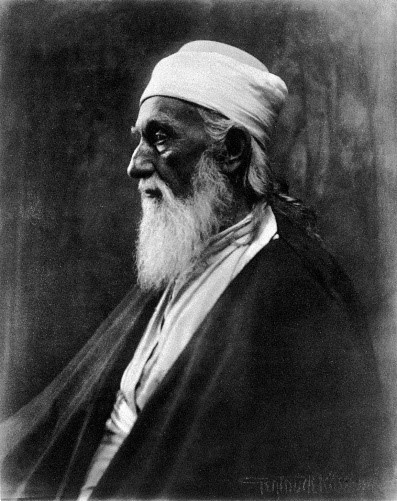
Although those who came into contact with ‘Abdu’l-Bahá were deeply impacted by His presence and personality, some appear not to have consciously or explicitly made the profound connection between the Revelation He propagated and the revolutionary period during which they were making their distinctive mark. Yet, other leading modernists did respond more directly and thoughtfully to His Message.
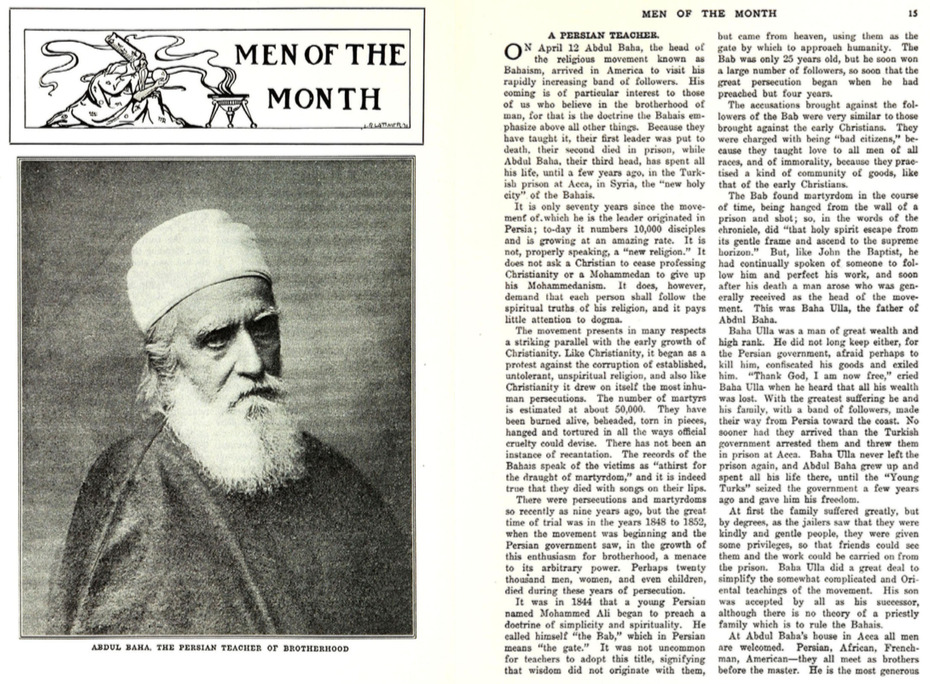
One of the Bahá’í principles promulgated with urgency by ‘Abdu’l-Bahá during His travels in the United States was the elimination of racial prejudice. His address at the fourth conference of the National Association for the Advancement of Colored People (NAACP) made a strong impact, for example, on sociologist and writer W.E.B. Du Bois, who published ‘Abdu’l-Bahá’s speech in full in the June 1912 edition of the NAACP’s official magazine The Crisis and made Him one of the ‘Men of the Month’ in the July issue. The Bahá’í teachings on race unity also resonated forcefully with Alain LeRoy Locke—the philosophical architect of the Harlem Renaissance artistic movement, which aimed to create a body of African American writing and art comparable to the best from Europe, to celebrate and transcend the stereotypes of black American culture and encourage social integration. Locke asserted that, drawing on African American sources, black “artists could transcend the narrow conventions of Western art creating a genuinely human art.”37Willliam B. Scott and Peter M. Rutkoff. New York Modern – The Arts and the City. Baltimore: John Hopkins University Press, 1999, p.139.
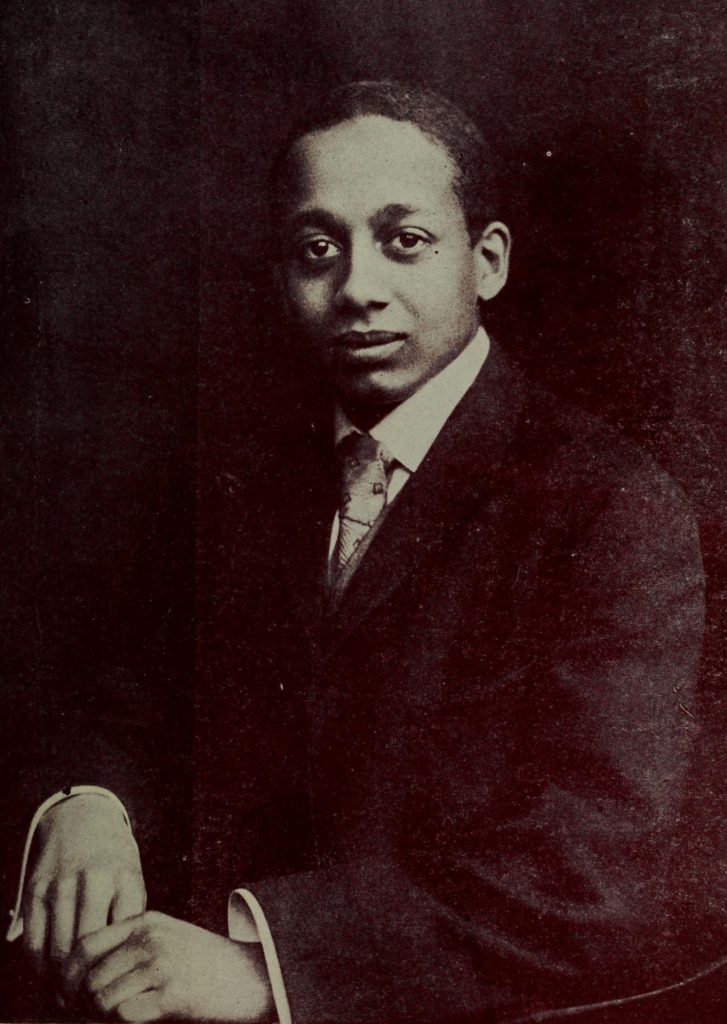
Locke formally accepted the Bahá’í Faith in 1918. Five years later, making his first pilgrimage to the Bahá’í Shrines in the Holy Land, he had a profoundly affecting experience in the Shrine of the Báb and the Shrine of ‘Abdu’l-Bahá, where he became “strangely convinced that the death of the greatest teachers is the release of their spirit in the world. …”38Alain Locke. “Impressions of Haifa”, The Bahá’í World Vol.3, 1928-1930. Wilmette: Bahá’í Publishing Trust, 1980, p.280.
Through their encounters with ‘Abdu’l-Bahá, then, thousands of souls in the West came into direct contact with the human embodiment of the spiritual forces released by the Revelation of Bahá’u’lláh, a Revelation through which, although few of them discerned it, “… the whole creation was revolutionized, and all that are in the heavens and all that are on earth were stirred to the depths.”39Bahá’u’lláh. Prayers and Meditations. Wilmette, Ill.: Bahá’í Publishing Trust, 1987, CLXXVIII, p.295 One particular aspect of that Revelation, of which most of the artists and writers He met probably remained unaware, concerned the radical redefinition of art as being an act of worship. ‘Abdu’l-Bahá described it thus to Juliet Thompson:
I rejoice to hear that thou takest pains with thine art, for in this wonderful new age, art is worship. The more thou strivest to perfect it, the closer wilt thou come to God. What bestowal could be greater than this, that one’s art should be even as the act of worshipping the Lord? That is to say, when thy fingers grasp the paintbrush, it is as if thou wert at prayer in the Temple.40Extract from a Tablet of ‘Abdu’l-Bahá, www.bahai.org/r/925134802
This consecration of humanity’s creative pursuits would, as ‘Abdu’l-Bahá foresaw it, in the centuries ahead give rise to “a new art, a new architecture, fused of all the beauty of the past, but new.”41Cited in Star of the West, Vol.VI No.4, 15 May 1915, pp.30-1. Despite all of its cultural ferment and experimentation, then, the early years of the twentieth century—with its “landscape of false confidence and deep despair, of scientific enlightenment and spiritual gloom,”42Century of Light. Haifa, Bahá’í World Centre, 2001, p.7. a landscape on which the “luminous figure of ‘Abdu’l-Bahá”43Century of Light. Haifa, Bahá’í World Centre, 2001, p.7 appeared— might thus be seen merely as the first streaks of the dawn of a “new cycle of human power.”44‘Abdu’l-Bahá in London. London: Bahá’í Publishing Trust, 1987, p.19.
The author is grateful to Debra Bricker Balkan, Hari Docherty, Dannah Edwards, Sky Glabush, Jan Jasion, Michael Karlberg, Arlette Manasseh, Anne Perry, and Nathan Rainsford for their assistance in the preparation of this essay.
Accounts of the meteoric rise, captivating claims, and mysterious public execution of the Báb—born 200 years ago in Shíráz, Iran—not only made a profound impression on the land of His birth, but also much further afield. From the distant reading rooms of Indian and English seats of learning to the salons of Paris’s Left Bank, writers and artists were enthralled by the tragedy of the Báb’s life and the appalling treatment meted out to His followers by the fanatical authorities of the time. This concise survey explores how this particular episode in humanity’s religious history resonated so strongly through the decades that followed.
Observers of the Bábí movement
During the nineteenth century, exotic stories and images from the Orient exerted a peculiar fascination on European minds. There were those, such as the British statesman Lord Curzon, who were impelled to make the journey east, motivated by imperialist ambitions. Others, however, including the decidedly anti-imperialist Edward Granville Browne of Cambridge University, genuinely identified with the cultures they discovered and returned with a new understanding of the potentialities of the peoples they encountered. One writer has maintained that the political theme of Europe regenerating a lifeless Asia had its literary and artistic counterpoint in the thought that the less sophisticated world overseas might be able to rejuvenate a greying Europe.
1Philip Darby, Three Faces of Imperialism, Britain and American Approaches to Asia and Africa 1870–1970 (New Haven: Yale University Press, 1987), p. 51.
The Comte de Gobineau’s Religions et Philosophies dans l’Asie Centrale (1865)—with its obvious parallels drawn between the life and martyrdom of the Báb with that of Jesus Christ—was the most influential volume in carrying the story to Western minds. The English poet and cultural critic Matthew Arnold, in A Persian Passion Play, wrote that the chief purpose
of Gobineau’s book was to give a history of the career of Mirza Ali Mahommed…the founder of Bâbism, of which most people in England have at least heard the name.
2Matthew Arnold, A Persian Passion Play, Essays in Criticism (London: Macmillan, 1884), p. 668. The notion that most people in England,
in Arnold’s view, were aware of the Báb indicates how deeply His fame had penetrated into far-off societies.
An encounter with Gobineau’s text also launched Browne on his quest. His only visit to Iran in 1887–88, recounted in A Year Amongst the Persians (1893), lit a fire which…would prove inextinguishable.
3A. J. Arberry, Oriental Essays, Portraits of Seven Scholars (Oxford: Oxford University Press, 1960), p. 171. The memoir of his sojourn did much to familiarize English readers with the Báb, His gentleness and patience, the cruel fate which had overtaken him, and the unflinching courage wherewith he and his followers, from the greatest to the least, had endured the merciless torments inflicted upon them by their enemies.
4Edward Granville Browne, A Year Amongst the Persians (London: A. C. Black, 1950), p. 330.
A. L. M. Nicolas, a French scholar born in Iran, was also intrigued by Gobineau’s work. Nicolas’s research, encompassing translations of several of the Báb’s major Writings, additionally contributed much to raising awareness of His life and teachings: My reflections on [The Seven Proofs by the Báb] that I had translated, filled me with a kind of intoxication and I became, little by little, profoundly and uniquely a Bábí. The more I immersed myself in these reflections, the more I admired the greatness of the genius of him who, born in Shíráz, had dreamt of uplifting the Muslim world…
5A. L. M. Nicolas, cited in Moojan Momen, The Bábí and Bahá’í Religions 1844–1944: Some Contemporary Western Accounts (Oxford: George Ronald Publisher, 1981), p. 37. Nicolas maintained a lifelong admiration for the Báb, concluding: Poor great Prophet, born in the heart of Persia, without any means of instruction, and who, alone in the world, encircled by enemies, succeeds by the force of his genius in creating a universal and wise religion…. I want people to admire the sublimity of the Báb, who has, moreover, paid with his life, with his blood, for the reforms he preached.
6Ibid., p. 38.
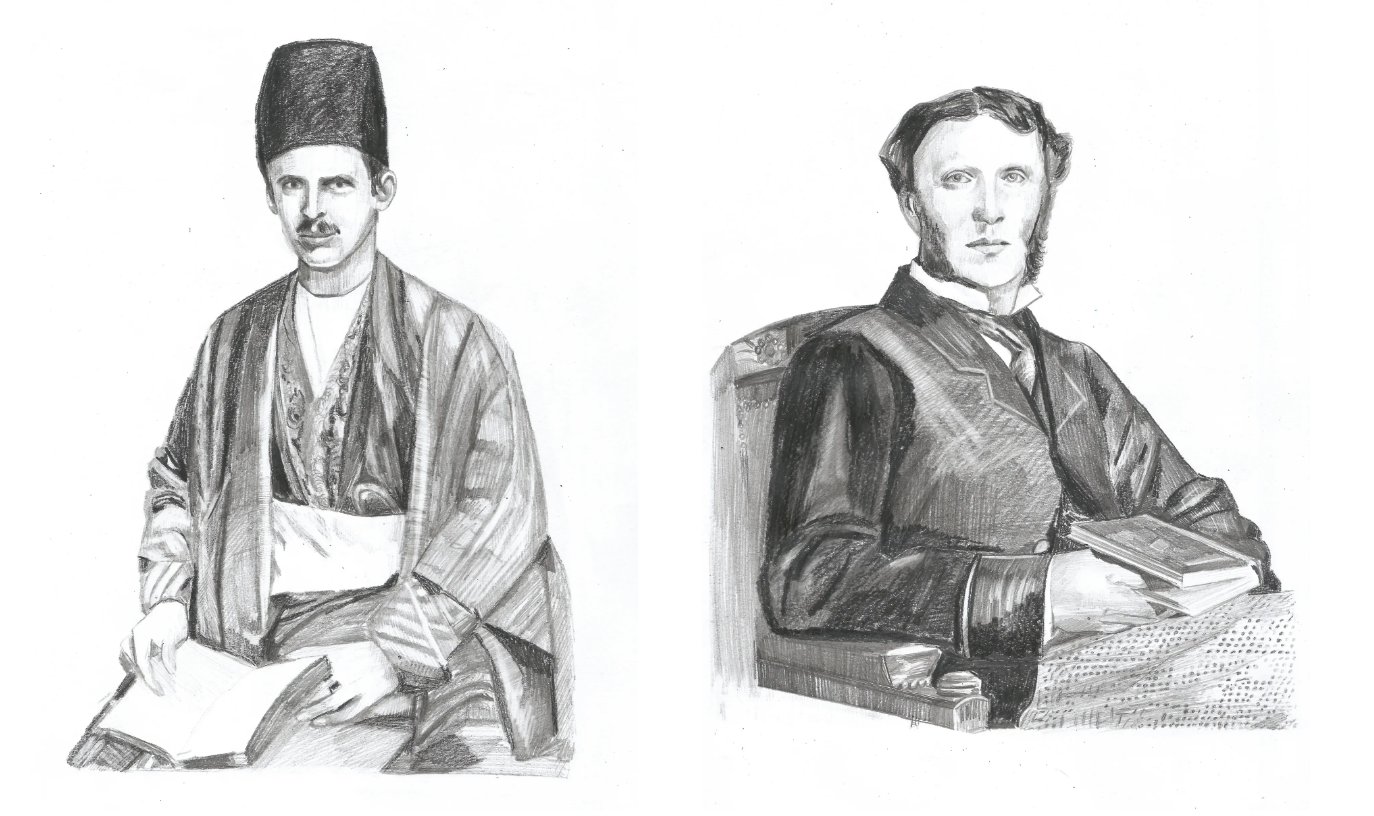
Poetic responses in Iran
The power of the written or spoken word is given great emphasis in the Bábí and Bahá’í scriptures. The Báb Himself cited a tradition, Treasures lie hidden beneath the throne of God; the key to those treasures is the tongue of poets.
7Nabíl-i-A’ẓam (Muḥammad-i-Zarandí). The Dawn-Breakers: Nabíl’s Narrative of the Early Days of the Bahá’í Revelation (Wilmette, Ill.: Bahá’í Publishing Committee, 1932), pp. 258–59. Among the early followers of the new faith were such distinguished poets as Táhirih, Varqá, Na’ím, and ‘Andalíb.8Baydá’í’s Memoir of the Poets of the First Bahá’í Century contains biographical notes about, and examples of work by, no fewer than 134 Bábí and Bahá’í poets.
Accounts of the Bábís generated an almost immediate response from writers in Iran itself. Mírzá Habíb-i-Shírází, known as Qá’iní, one of the country’s most eminent poets, was reportedly the first to extol the Báb in his work.9Nabíl-i-A’ẓam, The Dawn-Breakers, p. 258. Footnote 1. The news of more than 300 Bábís under siege at the Shrine of Shaykh Tabársí who, despite their lack of military expertise, held off the forces of the Sháh’s army for almost a year—notably aided by an exceptionally devastating display of swordsmanship by the Báb’s first follower Mullá Ḥusayn, who was but a religious scholar—evoked the enthusiasm of poets who, in different cities of Persia, were moved to celebrate the exploits of the author of so daring an act. Their poems helped to diffuse the knowledge, and to immortalize the memory, of that mighty deed.
10Nabíl-i-A’ẓam, The Dawn-Breakers, p. 333. In the West, reports of the beleaguered Bábís were extensively covered by the press11In an ongoing study, Jan Teofil Jasion has recorded 1380 articles for the years between 1845 and 1859. By the end of December 1845, more than 50 articles had been published in newspapers throughout Britain, France and the United States of America. By 1857, newspaper reports were printed in practically every capital city in Western Europe and as far afield as Java, Puerto Rico, the Bahamas, Hawaii and Canada., as well as described in travelogues by Robert Binning, Lady Sheil, and Jane Dieufloy.
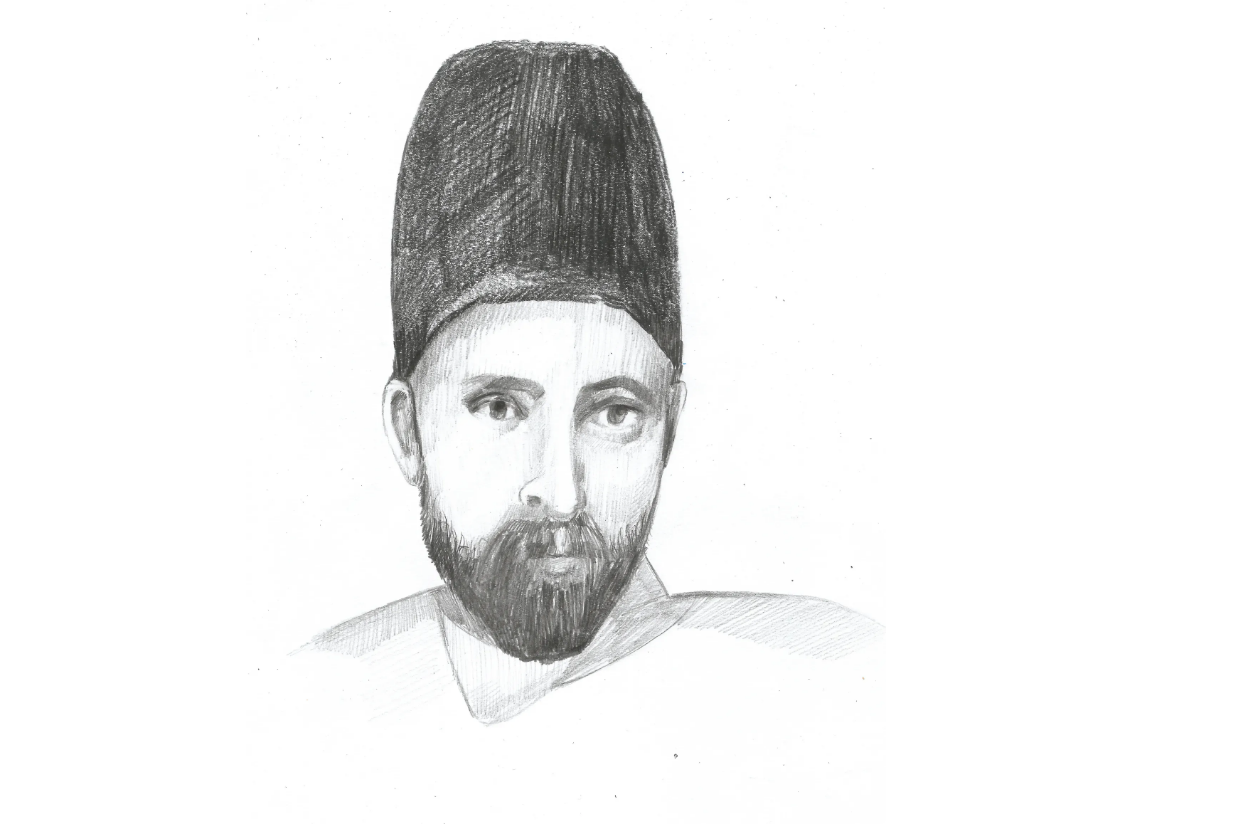
Táhirih, Qurratu’l-‘Ayn
The poet known as Táhirih, or Qurratu’l-‘Ayn, the first woman to follow the Báb, was rare among her gender at that time for her education and erudition. This ghazal, known as her signature piece, conveys her yearning devotion to the Beloved:
I would explain all my grief
Dot by dot, point by point
If heart to heart we talk
And face to face we meet.
To catch a glimpse of thee
I am wandering like a breeze
From house to house, door to door
Place to place, street to street.
In separation from thee
The blood of my heart gushes out of my eyes
In torrent after torrent, river after river
Wave after wave, stream after stream.
This afflicted heart of mine
Has woven your love
To the stuff of life
Strand by strand, thread to thread.12Táhirih, cited in Farzaneh Milani, Veils and Words: The Emerging Voices of Iranian Women Writers (London: I. B. Tauris, 1992).
More than any other element of the Bábí experience, it was the resolve and courage of Táhirih that seems to have excited the imagination of writers. Numerous volumes have been written about her—notably recalling her singular act of publicly removing her veil—not only in Persian, Arabic, and English but extensively in Urdu. Around 1870, after Bábís travelled to Mumbai, Táhirih’s story and poetry came to be well-known in the Indian sub-continent. The influential Punjabi-born poet, politician and philosopher Allama Muhammad Iqbal listed Táhirih among those whose songs bestow constancy to the souls because their songs derive their heat from the universe of inner-heat.
13Sabir Afaqi, Qurratu’l-’Ayn Táhirih in Urdu Literature, in Táhirih in History: Perspectives on Qurratu’l-Ayn from East and West, ed. Sabir Afaqi and Jan Teofil Jasion (Los Angeles: Kalimát Press), 2004, p. 31. In his Javid Nama (1932), Iqbal lists Táhirih as one of three martyr-guides.
Think you not Táhirih has left this world.
Rather she is present in the very conscience of her age.14Muhammad Iqbal, cited in Ibid., p. 31.
In Europe, as early as 1874, an Austrian novelist and women’s rights activist Marie von Najmajer, had written an epic poem, Gurret-ül-Eyn, believed to be the first composed in a Western language in honor of the new religion. Four years later, William Michael Rossetti mentioned both the Báb and Táhirih in a lecture given in various cities about the English poet Shelley.15William Michael Rossetti, in The Dublin University Magazine, (February/March 1878). Rossetti observed that Táhirih had an almost magical influence over large masses of the population,
16Ibid. and that the protagonists of Shelley’s poem, The Revolt of Islam, anticipate both her life and that of the Báb. In this work, Shelley seems to have captured the spirit of expectation of that time, foreseeing the imminent advent of two Divine beings:
And a voice said:
Thou must a listener be17Percy Bysshe Shelley, The Revolt of Islam (London: C. and J. Oliver, 1818), Canto I: LVIII.
This day—two mighty Spirits now return,
Like birds of calm, from the world’s raging sea,
They pour fresh light from Hope’s immortal urn;
A tale of human power—despair not—list and learn!
Explaining the significance of a verse from Háfiz, the Báb had said, It is the immediate influence of the Holy Spirit that causes words such as these to stream from the tongue of poets the significance of which they themselves are often times unable to apprehend.
18Nabíl-i-A’ẓam, p. 259. In similar vein, Shelley had not long before declared that poets are the hierophants of an unapprehended inspiration, the mirrors of the gigantic shadows which futurity casts upon the present, the words which express what they understand not; the trumpets which sing to battle and feel not what they inspire….
19Percy Bysshe Shelley, cited in Shelley’s Poetry and Prose, ed. Donald Reiman and Sharon Powers (New York: W. W. Norton, 1977). The creative forces that accompany the pronouncements of a Manifestation of God—or even anticipate them—thus appear to prompt the spiritual sensibilities of receptive souls.
Throughout the twentieth century, Táhirih’s fame spread further abroad. The journalist and outstanding Bahá’í teacher Martha Root, who penned a monograph about her, noted that, As I have travelled in the five continents, I have seen how her life has influenced women, and men too, throughout the world.
20Martha Root, Táhirih the Pure (Los Angeles: Kalímat Press, 1981), p. 43. A 1960 public sculpture in Baku, Azerbaijan, by Fuad Abdurrahmanov, depicting a woman casting aside her veil, is said to have been inspired by Táhirih.21See https://news.bahai.org/story/1150/ And, as recently as in 2017, Azerbaijan’s National Museum of History held a celebration recognizing Táhirih’s dedication and contribution to the advancement of women. Táhirih is held in high regard,
explained Professor Azer Jafarov of Baku State University. She influenced modern literature, raised the call for the emancipation of women, and had a deep impact on public consciousness.22Ibid.
Around the same time that Táhirih made her appearance unveiled at the Conference of Badasht in June–July 1848, the first women’s rights convention in the United States was being held at Seneca Falls, at which was launched the women’s suffrage movement in America. In the estimation of Western women, the acts of Táhirih were interpreted through the lens of their campaign for the right to vote. In Britain in 1911, the Women’s Freedom League newspaper ran a three-part article by campaigner Charlotte Despard titled, A Woman Apostle in Persia.
23Despard, Charlotte, A Woman Apostle in Persia, The Vote, Vol. IV No.101. 30 September 1911: pp.280-1. When an English Bahá’í, Mary Blomfield, petitioned King George V in person to ease the maltreatment of imprisoned suffragettes, an American Bahá’í dubbed her the Western Qurratu’l-Ayn.
24Letter from Joseph Hannen to Lady Blomfield, 7 September 1914. United States Bahá’í Archives.
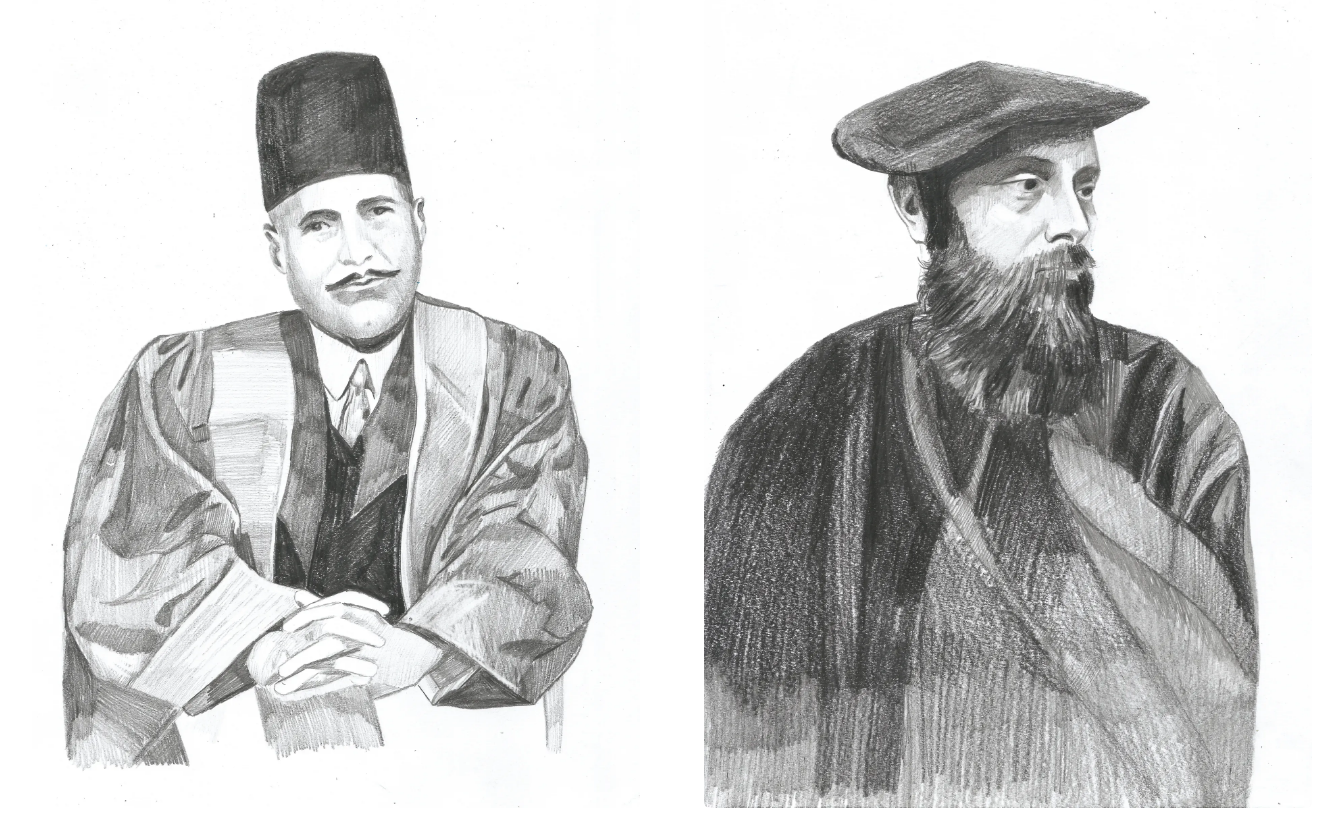
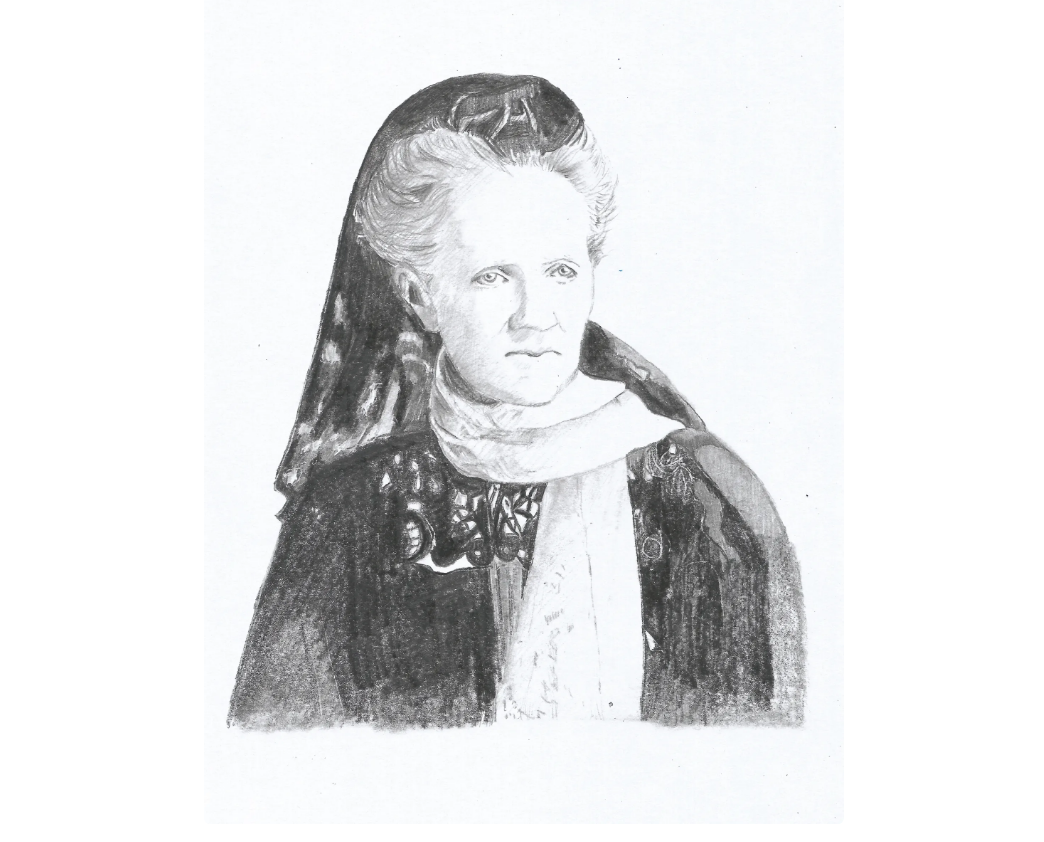
The salons of Paris
The first European novel that was set against the episode of the Báb was published in France 1891. In Un Amour au Pays de Mages, A. de Saint-Quentin—a French consular official and colleague of Gobineau’s—created a love story between a humble dervish and the daughter of a cleric in Qazvín played out amid the events of Bábí history.
Writer Jules Bois had also been so moved by the story of events in faraway Iran that, during a journey through the Holy Land, he had stopped at Mount Carmel to place flowers on the tomb of the Báb.
25Jan Teofil Jasion, ‘Abdu’l-Bahá in France 1911 & 1913 (Paris: Éditions bahá’íes France, 2016), p. 189.
Writing in 1925, Bois recalled that, All Europe was stirred to pity and indignation over the martyrdom of the Báb, July 9 1850 … among the littérateurs of my generation, in the Paris of 1890 the martyrdom of the Báb was still as fresh a topic as had been the first news of his death. We wrote poems about him. Sarah Bernhardt entreated Catulle Mendès for a play on the theme of this historic tragedy …. I was asked to write a drama entitled Her Highness the Pure, dealing with the story of another illustrious martyr of the same cause—a woman, Quarratul-Ayn [sic] the Persian Joan of Arc and the leader of emancipation for women of the Orient.
26Jules Bois, cited in ibid.
Neither of the proposed plays of Mendès or Bois materialized. However, Bois did meet ‘Abdu’l-Bahá in Paris on 11 November 1911, at the home of composer Hermann Bemberg, where they performed extracts from an opera they had co-written with Eustache de Lorey, titled Leïlah. Set in Shíráz, the opera contained many references to mystical Persia. It was staged in Monaco three years later.27Jan Teofil Jasion, ‘Abdu’l-Bahá in France 1911 & 1913.
In 1910, the Paris-based American heiress Laura Clifford Barney—who would be active in the International Council of Women in the following decades and its representative to the League of Nations—had published her own, never performed, drama, God’s Heroes, centering on Táhirih. In its preface, Barney described her play as but a fragment of one of the most dramatic periods in history and … but a limited presentation of the most vast philosophy yet known to man.
The theatre, like all other forces may upbuild or shatter. It can be a mighty instrument for spreading ideas broadcast; and, for this reason, I believe that the wave of regeneration, which is sweeping over the world, should take form also on the stage; and am trying, therefore, in this play, to bring before the public some of the most inspiring events of our epoch.
I have, therefore, presented to the public a few episodes in the early Babi history, and only a few of the noted characters of that period: yet, even this imperfect sketch should suffice to give an idea of the vastness of the movement.28Laura Clifford Barney, God’s Heroes (London: Kegan Paul, Trench, Trübner, 1910), p. v–vi.
Barney thought it preferable
not to portray the Báb or Bahá’u’lláh in any way for certain beings cannot be adequately impersonated.
However there is no such self-restriction in her depiction of Táhirih, who stands forth in history as an example of what the disciple of truth can accomplish despite hampering custom, and violent persecution.
29Ibid., p. viii.
At one moment in the play, Barney gives to Táhirih words that proclaim the advent of a new Revelation:
From all sides I see new life rising; the struggle between the hardened soil and the maturing seed is over. Soon, upon all things, summer will spread victorious beauty!
… even the end has a beginning for spring will again conquer, sister mine. So, when, as now, ancient faiths have become rigid in cold dead forms, a new faith germinates in the souls of men.30Ibid. p. 17.By then a devoted Bahá’í herself, Barney’s intention in presenting this history on stage was made clear to her readers at the outset:
… I hope, notwithstanding, to give you a glimpse of Eastern glory, and to awaken your interest in this great movement, the universal religion—Bahaism, which is today bringing peace and hope to expectant humanity.31Ibid. p. viii.
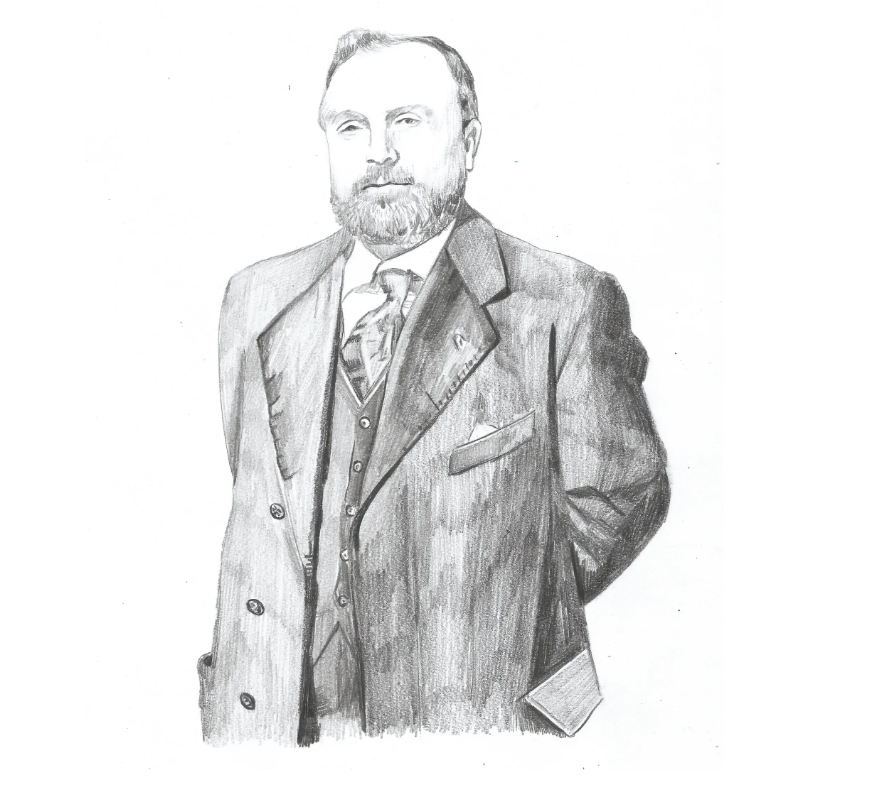
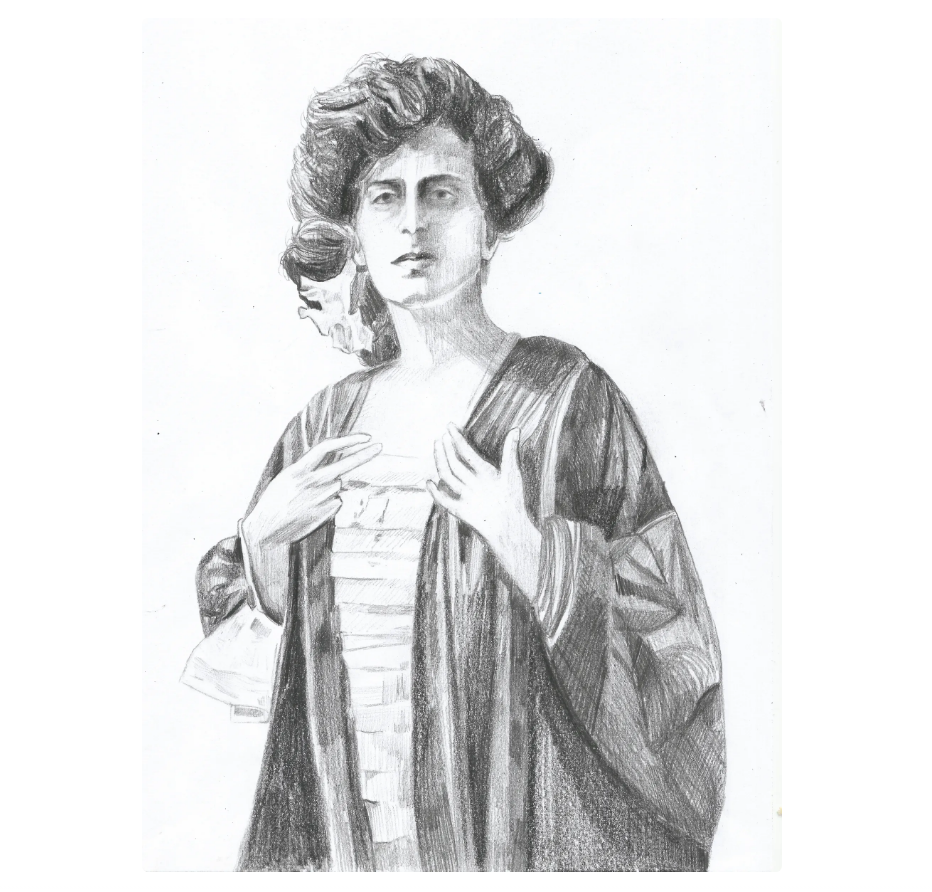
A Russian stage drama
In God Passes By, published in 1944 to mark the centenary of the Declaration of the Báb, Shoghi Effendi recorded for posterity another piece of theater:
A Russian poetess, member of the Philosophic, Oriental and Bibliological Societies of St. Petersburg, published in 1903 a drama entitled
The Báb,which a year later was played in one of the principal theatres of that city, was subsequently given publicity in London, was translated into French in Paris, and into German by the poet Fiedler, was presented again, soon after the Russian Revolution, in the Folk Theatre in Leningrad, and succeeded in arousing the genuine sympathy and interest of the renowned Tolstoy, whose eulogy of the poem was later published in the Russian press.32Shoghi Effendi, God Passes By (Wilmette: Bahá’í Publishing Trust, 1999), p. 56.
The drama was penned by Izabella Grinevskaia, who probably first encountered the story of the Báb while researching in a St. Petersburg academic library. Several Russian scholars—including Aleksander Kazembeg, Albert Dorn, Captain A. M. Tumansky and Baron Victor Rozen—had published articles about the Báb. Published in April 1903, Grinevskaia’s play, received favorable reviews in the press, some of which quoted from it at length. One noted that the story could move a Russian as well as a Persian. It is almost strange that in our literature no-one has come to write about such a wonderful, true-to-life tragedy.
33Jan Teofil Jasion, Táhirih on the Russian Stage, in Táhirih in History, p. 233. First seen in St. Petersburg on 4 January 1904, the work conveyed its message of peace, love, tolerance, and brotherhood so successfully that, after four performances, it was banned for five years by the Tsar’s censor. It was, however, performed in Baku on 28 April and Astrakhan during the first week of December 1904. A second edition was published in 1916 and staged the following year. In 1922 the last recorded staging took place in Ashgabat in Turkmenistan.
Among those who praised Grinevskaia’s play was Leo Tolstoy. A Russian journalist visiting the great author in 1903, described finding Tolstoy deeply immersed in reading the drama
and was charged by him to give his admiring appreciation to it author.
34Moojan Momen, The Bábí and Bahá’í Religions 1844–1944. p. 51. But Tolstoy’s curiosity about the Báb preceded his receiving Grinevskaia’s text. In April 1899, for example, the poet Rainer Maria Rilke paid a visit to Tolstoy with the Russian psychoanalyst Lou Andreas-Salomé and her husband, the orientalist Friedrich Carl Andreas, who had published a paper about the Bábís. Salomé later reported that Tolstoy paid little attention to her and Rilke, rather his interest was more focused on deep and invigorating discussions about the Bábí movement
with her husband.35Sasha Dehghani, Die ‘persische Jeanne d’Arc’: Zum Nachleben einer Märtyrerin,, Trajekte (Berlin) nr.15 (Oktober 2007).
In a letter to Grinevskaia, Tolstoy wrote, I have known of the Bábís for a long time and am much interested in their teachings. It seems to me that they have a great future … because they have thrown away the artificial superstructures which separate [the religions] from one another and are aiming at uniting all mankind in one religion …. And therefore, in that it educates men to brotherhood and equality and to the sacrificing of their sensual desires in God’s service, I sympathise with Bábism with all my heart.
36Moojan Momen, The Bábí and Bahá’í Religions 1844–1944. p. 55.
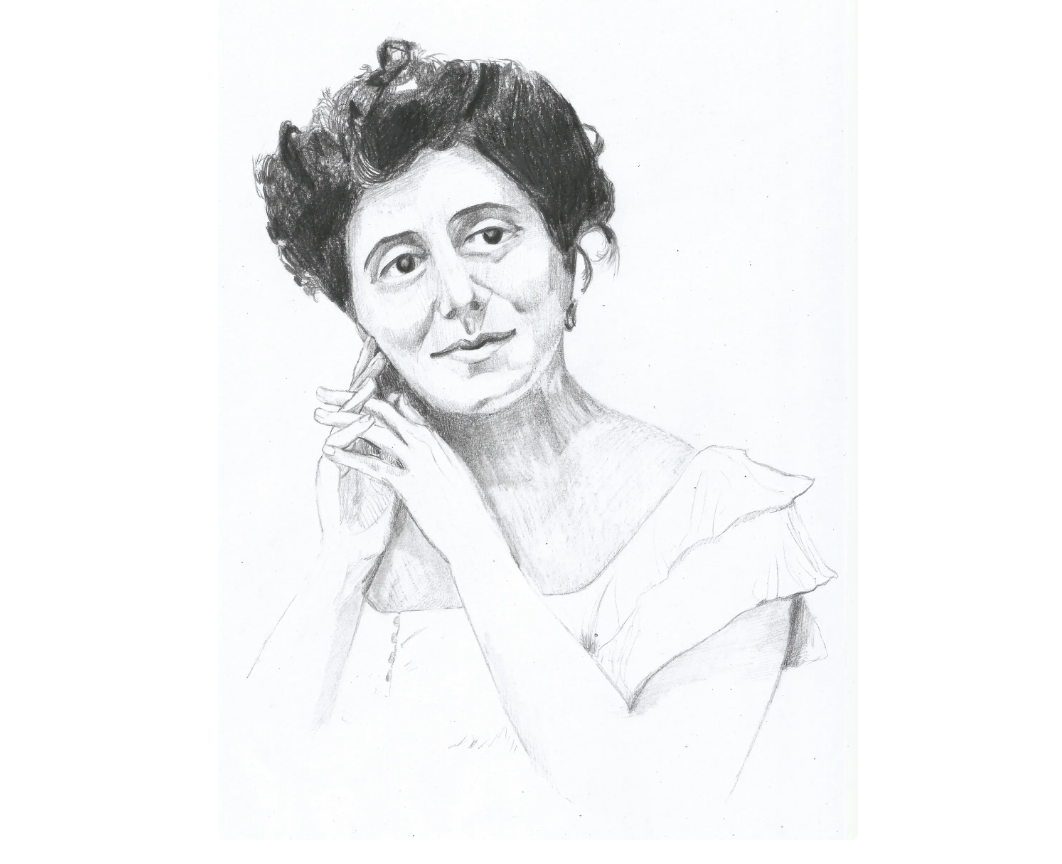
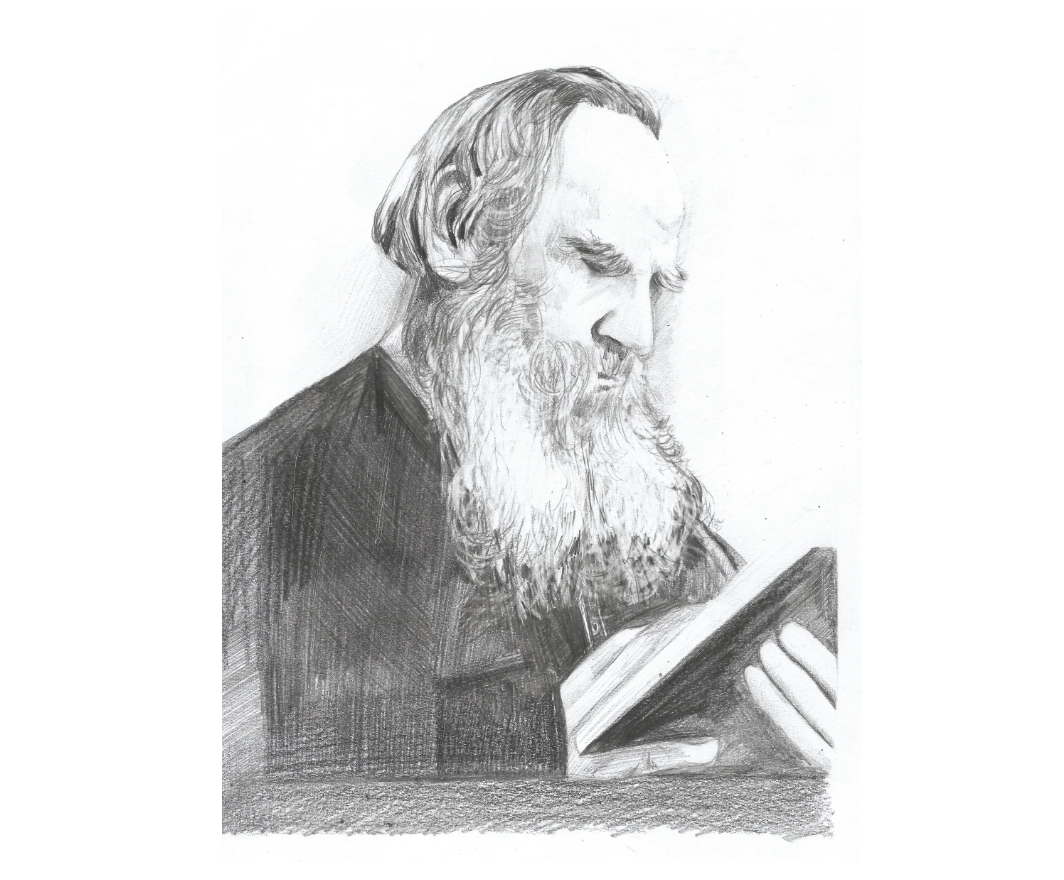
Response in the twentieth century
The Báb and His followers were thus a source of curiousity and inspiration to many writers, intrigued by His teachings and captivated by the heartbreak of their story. Later, as the Heroic Age
of Bahá’í history came to an end with the passing of ‘Abdu’l-Bahá in 1921, the Bahá’í Faith, under the direction of its Guardian, Shoghi Effendi, began to evolve into a distinct and independent, world-embracing religion, spreading to an ever-increasing number of territories. One of the reasons for Shoghi Effendi’s translation of The Dawn-Breakers: Nabíl’s Narrative of the Early Days of the Bahá’í Revelation was to give newer Bahá’ís in the West both a vivid introduction to the origins of their Faith, much of which was unknown to them, and an inspirational tool to encourage their own sacrificial services in the Faith’s progress. It was also the Guardian’s hope that The Dawn-Breakers would provide artists with source material for their work: It is surely true that the spirit of these heroic souls will stir many artists to produce their best. It is such lives that in the past inspired poets and moved the brush of the painters.
37Shoghi Effendi, cited in Extracts from the Bahá’í Writings on the Subject of the Importance of the Arts in Promoting the Faith, Compilation of Compilations Prepared by the Research Department of the Universal House of Justice, vol. 3 (Ingleside: Bahá’í Publications Australia, 2000), pp. 27–28.
In comparison to the outpouring of those early decades of literary responses to the Báb, general works inspired by the Bábí period may have dwindled for much of the 20th century. However, following the publication of The Dawn-Breakers up until today, Bahá’ís themselves have paid homage to the Báb and the heroes of Bábí history through countless works of art, poetry, theater, film, and music, in a wide range of languages and forms of cultural expression. Two American Bahá’ís who received widespread public acclaim in the pursuit of their art and deserve brief mention here, to exemplify how The Dawn-Breakers has impacted upon creative practitioners, are the painter Mark Tobey and the poet Robert Hayden.
When Tobey was on his second pilgrimage to the Holy Land in 1935, Shoghi Effendi told him that he was free to depict the early heroes of the Faith but not its Founders. Up until that time, some of the early western Bahá’ís who were painters had not attempted to illustrate any events from Bábí history, let alone attempt to convey more mystical concepts. Tobey, however, conversant with the moves toward abstraction in modernist European painting, found that his emerging visual language could be deployed not only for evoking historical events but also metaphysical ideas.
One of Tobey’s most explicit Bábí-inspired works is Movement Around a Martyr (1938). In it, he draws on his deep knowledge of renaissance art, especially the pietà figure of the martyred Christ, to depict the physical and spiritual forces that circle about a saintly figure who has been put to death. The entire image, which from a distance might be read as an all-seeing eye or maelstrom, spirals out of a small central circle, perhaps the Primal Point,
as the Báb described Himself, from which has been generated all created things.
38The Báb, Selections from the Writings of the Báb (Haifa: Bahá’í World Centre, 1982), p. 12. Swirling around the martyred figure, one lifeless arm hanging down, are mourners and worshippers, priests and helmeted guards, while more amorphous angelic figures circle above. In this work, Tobey draws an explicit parallel between the Bábí episode and the archetypal events from previous religious dispensations.
Meanwhile, in his poem, Dawnbreaker, the distinguished American poet Robert Hayden, who served from 1976 to 1978 as Consultant in Poetry to the U.S. Library of Congress, a role today known as U.S. Poet Laureate, takes as his inspiration the description of the humiliation of Hájí Sulaymán Khán, whose final punishment was to have holes gouged into his flesh into which were inserted burning candles:
Ablaze
with candles sconced
in weeping eyes
of wounds,He danced
through jeering streets
to death; oh sang
against. The drumming
mockery God’s praise.
Flames nested in
his fleshFed the
fires that consume
us now, the fire that
will save.39Robert Hayden, Angle of Ascent (New York: Liveright, 1966), p. 80.
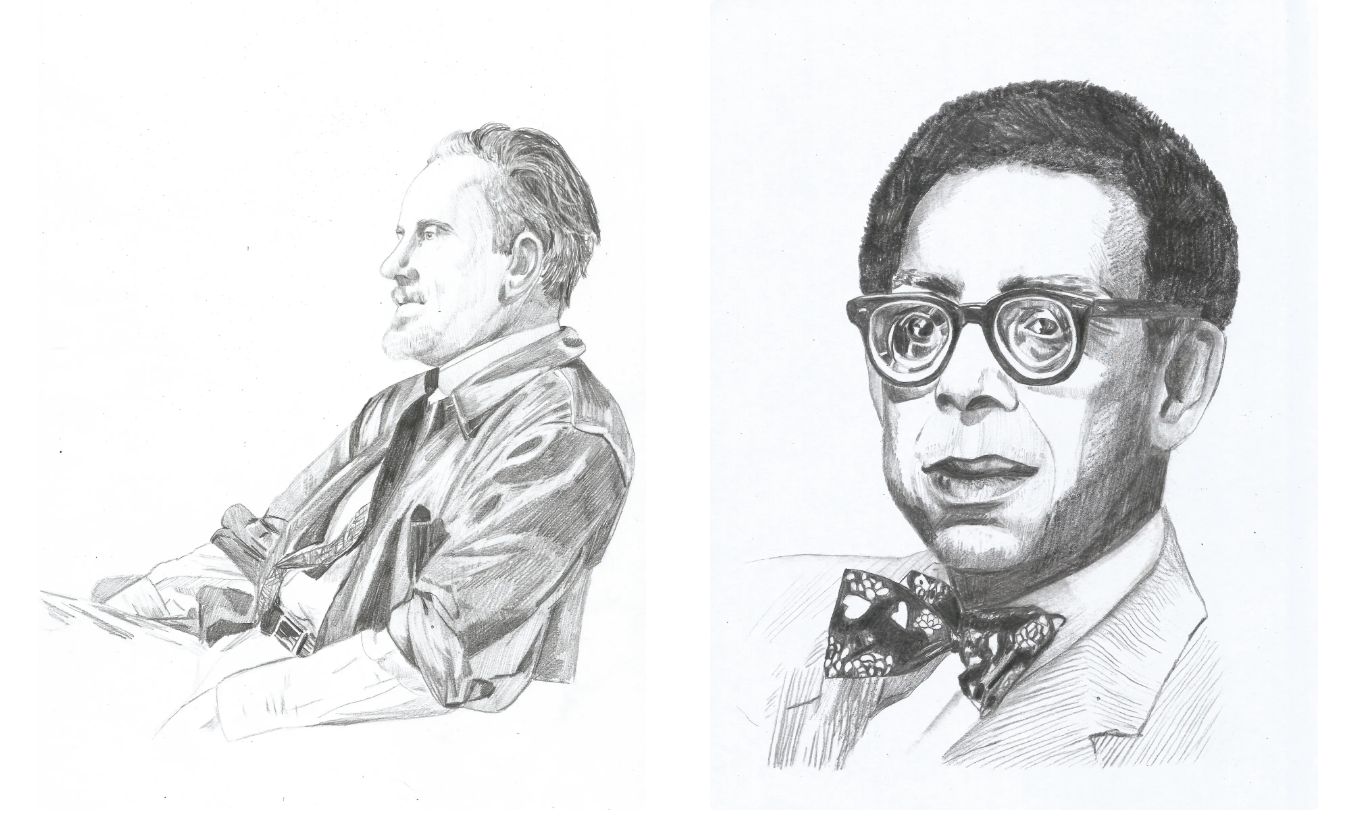
A continuing story
There are two aspects to the story of the Báb—His captivating personal demeanor and the harsh treatment of His followers—that particularly seem to have sparked the imagination of writers and then later, artists. The English divine Thomas K. Cheyne recorded that the Báb’s combination of mildness and power is so rare that we have to place him in a line with super-normal men ….
40Thomas K. Cheyne, The Reconciliation of Race and Religions (London: Adam and Charles Black, 1914), p. 74. Curzon noted, that [t]ales of magnificent heroism illumine the bloodstained pages of Bábí history …. Of no small account, then, must be the tenets of a creed that can awaken in its followers so rare and beautiful a spirit of self-sacrifice.
41George N. Curzon, Persia and the Persian Question (London: Frank Cass, repr. 1966), p. 501.
To this day, the Báb continues to fascinate not only Bahá’ís around the world, but scholars of history and religion, artists, musicians, writers and dramatists. Anticipating the worldwide celebrations of both the bicentenaries of Bahá’u’lláh in 2017 and the Báb in 2019, the Universal House of Justice wrote:
At the heart of these festivities must be a concerted effort to convey a sense of what it means for humanity that these two Luminaries rose successively above the horizon of the world. Of course, this will take different forms in different contexts, extending to a myriad artistic and cultural expressions, including songs, audio-visual presentations, publications and books.42Universal House of Justice, To all National Spiritual Assemblies, 18 May 2016 (Bahá’í World Centre, 2016, mimeographed), p. 1.
The bicentenary of the Birth of the Báb in October 2019 did indeed give rise to an outpouring of artistic expressions from people on every continent, a sure reminder of the profound influence that the life and mission of the Báb is continuing to have, and will increasingly exert, on artistic expression worldwide.
Much then is still to be seen and heard, drawn and painted, spoken and sung, acted upon the stage, or captured on film—as humanity increasingly responds to the advent of a Divine Revelation and its martyred Prophet-Herald, Who fascinated contemporary commentators in the middle of the nineteenth century, and Who continues to speak to hearts and minds in the twenty-first.
The year 1994 marked the 150th anniversary of the declaration of His mission by the Báb (Siyyid ‘Alí-Muhammad, 1819–1850), one of the two Founders of the Bahá’í Faith. The moment invites an attempt to gain an overview of the extraordinary historical consequences that have flowed from an event little noticed at the time outside the confines of the remote and decadent society within which it occurred.
The first half of the 19th century was a period of messianic expectation in the Islamic world, as was the case in many parts of Christendom. In Persia a wave of millenialist enthusiasm had swept many in the religiously educated class of Shí‘ih Muslim society, focused on belief that the fulfillment of prophecies in the Qur’án and the Islamic traditions was at hand. It was to one such ardent seeker1Mullá Husayn-i-Bushru’í. that, on the night of 22–23 May 1844, the Báb (a title meaning Gate
) announced that He was the Bearer of a Divine Revelation destined not only to transform Islam but to set a new direction for the spiritual life of humankind.
During the decade that followed, mounting opposition from both clergy and state brought about the martyrdom of the Báb, the massacre of His leading disciples and of several thousands of His followers, and the virtual extinction of the religious system that He had founded. Out of these harrowing years, however, emerged a successor movement, the Bahá’í Faith, that has since spread throughout the planet and established its claim to represent a new and independent world religion.
It is to Bahá’u’lláh (Mírzá Husayn-‘Alí, 1817–1892), that the worldwide Bahá’í community looks as the source of its spiritual and social teachings, the authority for the laws and institutions that shape its life, and the vision of unity that has today made it one of the most geographically widespread and ethnically diverse of organized bodies of people on the planet. It is from Bahá’u’lláh that the Faith derives its name and toward Whose resting place in the Holy Land that the millions of Bahá’ís around the world daily direct their thoughts when they turn to God in prayer.
These circumstances in no way diminish, however, the fact that the new Faith was born amid the bloody and terrible magnificence surrounding the Báb’s brief mission, nor that the inspiration for its worldwide spread has been the spirit of self-sacrifice that Bahá’ís find in His life and the lives of the heroic band that followed Him. Prayers revealed by the Báb and passages from His voluminous writings are part of the devotional life of Bahá’ís everywhere. The events of His mission are commemorated as annual holy days in tens of thousands of local Bahá’í communities.2The anniversary of the birth of the Báb is commemorated on the day following the occurrence of the eighth new moon in the Bahá’í year, which moves between mid-October and mid-November; His declaration, 23 or 24 May; and His martyrdom, 9 or 10 July. On the slopes of Mount Carmel, the golden-domed Shrine where His mortal remains are buried dominates the great complex of monumental buildings and gardens constituting the administrative center of the Faith’s international activities.
In contemporary public awareness of the Bahá’í community and its activities, however, the life and person of Bahá’u’lláh have largely overshadowed those of the Báb. In a sense, it is natural that this should be the case, given the primary role of Bahá’u’lláh as the fulfillment of the Báb’s promises and the Architect of the Faith’s achievements. To some extent, however, this circumstance also reflects the painfully slow emergence of the new religion from obscurity onto the stage of history. In a perceptive comment on the subject, the British historian Arnold Toynbee compared the level of appreciation of the Bahá’í Faith in most Western lands with the similarly limited impression that the mission of Jesus Christ had succeeded in making on the educated class in the Roman Empire some 300 years after His death.3Arnold Toynbee, A Study of History, vol. 8 (London: Oxford, 1954). 117. Since most of the public activity of the Bahá’í community over the past several decades has focused on the demanding task of presenting Bahá’u’lláh’s message, and elaborating the implications of its social teachings for the life of society, the Faith’s 19th-century Persian origins have tended to become temporarily eclipsed in the public mind.
Indeed, Bahá’ís, too, are challenged by the implications of the extraordinary idea that our age has witnessed the appearance of two almost contemporaneous Messengers of God. Bahá’u’lláh describes the phenomenon as one of the distinguishing characteristics of the new religion and as a mystery central to the plan of God for the unification of humankind and the establishment of a global civilization.4Shoghi Effendi, The World Order of Bahá’u’lláh: Selected Letters, 2d rev ed (Wilmette: Bahá’í Publishing Trust, 1974), 123–24.
Fundamental to the Bahá’í conception of the evolution of civilization is an analogy to be found in the writings of both the Báb and Bahá’u’lláh. It draws a parallel between the process by which the human race has gradually been civilized and that whereby each one of its individual members passes through the successive stages of infancy, childhood, and adolescence to adulthood. The idea throws a measure of light on the relationship which Bahá’ís see between the missions of the two Founders of their religion.
Both the Báb and Bahá’u’lláh—the former implicitly and the latter explicitly—describe the human race as standing now on the brink of its collective maturity. Apart from the Báb’s role as a Messenger of God, His advent marks the fruition of the process of the refining of human nature which thousands of years of Divine revelation have cultivated. It can be viewed, in that sense, as the gateway through which humankind must pass as it takes up the responsibilities of maturity. Its brevity itself seems symbolic of the relative suddenness of the transition.5I owe this interesting suggestion to Dr. Hossain Danesh.
At the individual level, no sooner does one cross the critical threshold of maturity in his or her development than the challenges and opportunities of adulthood beckon. The emerging potentialities of human life must now find expression through the long years of responsibility and achievement: they must become actualized through marriage, a profession and family, and service to society. In the collective life of humanity, it is the mission of Bahá’u’lláh, the universal Messenger of God anticipated in the scriptures of all the world’s religions.
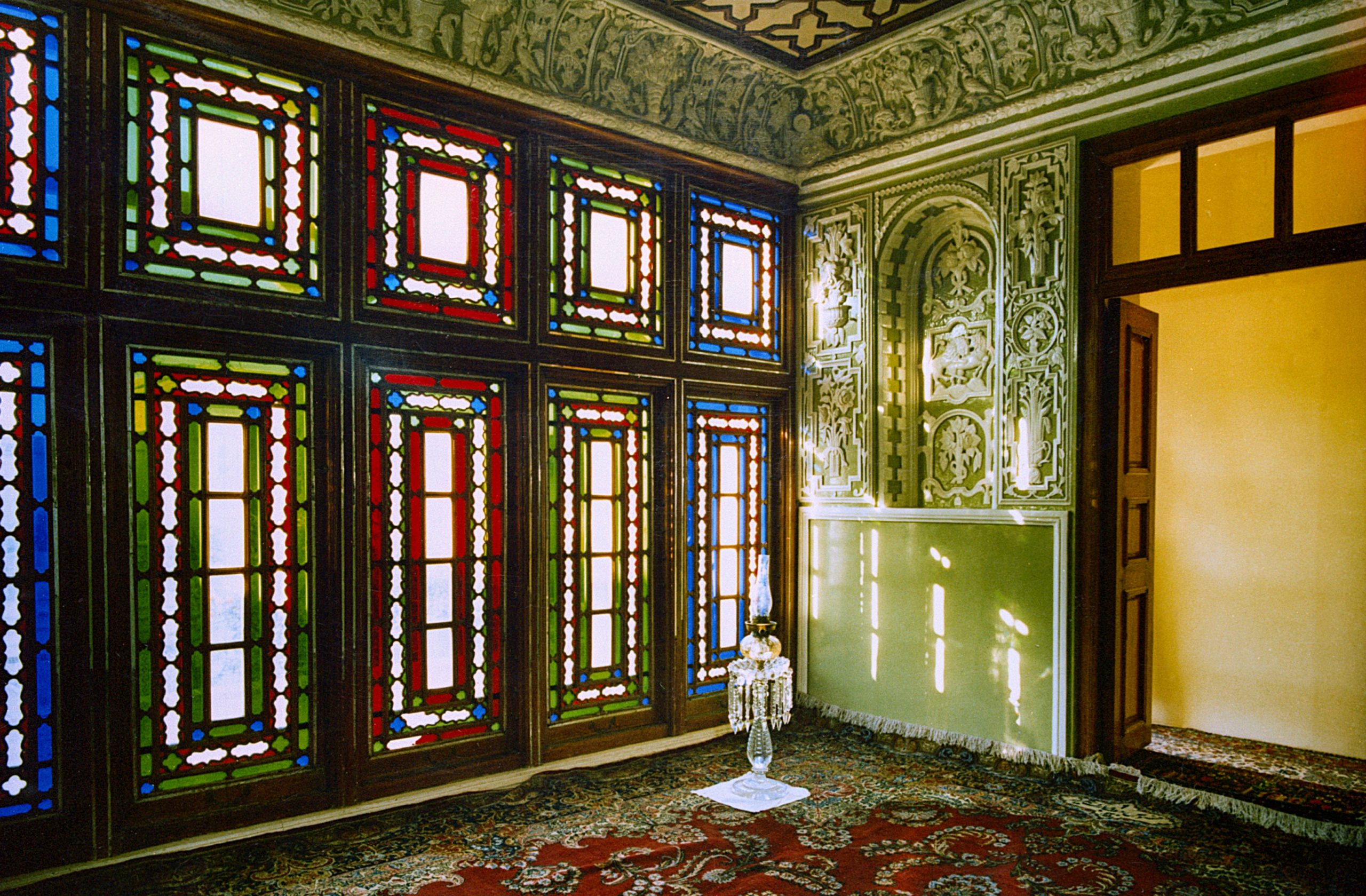
Even as late as the end of the 19th century, however, it was the Báb who figured as the central Personality of the new religion among most of those Westerners who had become aware of its existence. Writing in the American periodical Forum in 1925, the French literary critic Jules Bois remembered the extraordinary impact which the story of the Báb continued to have on educated opinion in Europe as the 19th century closed:
All Europe was stirred to pity and indignation … . Among the littérateurs of my generation, in the Paris of 1890, the martyrdom of the Báb was still as fresh a topic as had been the first news of His death in 1850. We wrote poems about Him. Sarah Bernhardt entreated Catulle Mendès for a play on the theme of this historic tragedy.6Shoghi Effendi, God Passes By (1944; reprint, Wilmette: Bahá’í Publishing Trust, 1974), 56, and The Bahá’í World, vol. 9, 1940–1944 (1945; reprint, Wilmette: Bahá’í Publishing Trust, 1981), 588.
Writers as diverse as Joseph Arthur de Gobineau, Edward Granville Browne, Ernest Renan, Aleksandr Tumanskiy, A.L.M. Nicolas, Viktor Rosen, Clément Huart, George Curzon, Matthew Arnold, and Leo Tolstoy were affected by the spiritual drama that had unfolded in Persia during the middle years of the 19th century. Not until the early part of our own century did the name the Bahá’í Cause,
which the new religion had already adopted for itself as early as the 1860s, replace the designation of Bábí movement
in general usage in the West.7Persistent use of the term Bábí in Iranian Muslim attacks on the Bahá’í Faith over the years has tended to be a reflection of the spirit of animosity incited by its original 19th-century clerical opponents.
That this should have been the case was no doubt a reflection of the degree to which the brief but incandescent life of the Báb seemed to catch up and embody cultural ideals that had dominated European thought during the first half of the 19th century, and which exercised a powerful influence on the Western imagination for many decades thereafter. The concept commonly used to describe the course of Europe’s cultural and intellectual development during the first five or six decades of the 19th century is Romanticism. By the century’s beginning, European thought had begun to look beyond its preoccupation with the arid rationalism and mechanistic certainties of the Enlightenment toward an exploration of other dimensions of existence: the aesthetic, the emotional, the intuitive, the mystical, the natural,
the irrational.
Literature, philosophy, history, music, and art all responded strongly and gradually exerted a sympathetic influence on the popular mind.
In England, where the tendency was already gathering force as the century opened, one effect was to produce perhaps the most spectacular outpouring of lyrical poetry that the language has ever known. Over the next two to three decades these early insights were to find powerful echoes throughout Western Europe. A new order of things, a whole new world, lay within reach, if man would only dare what was needed. Liberated by the intellectual upheaval of the preceding decades, poets, artists and musicians conceived of themselves as the voice of immense creative capacities latent in human consciousness and seeking expression; as prophets
shaping a new conception of human nature and human society. With the validity of traditional religion now shrouded in doubt, mythical figures and events from the classical past were summoned up to serve as vehicles for this heroic Ideal:
To suffer woes which Hope thinks infinite;
To forgive wrongs darker than Death or Night;
To defy Power which seems Omnipotent;
To love, and bear; to hope, till Hope creates
From its own wreck the thing it contemplates …
This alone is Life, Joy, Empire and Victory.8Percy Bysshe Shelley, Prometheus Unbound, bk. 4, ll. 569–78.
The same longings had awakened in America in the decades immediately preceding the Civil War and were to leave an indelible imprint on public consciousness. All of the transcendentalists became deeply attracted by the mystical literature of the Orient: the Bhagavad Gita, the Ramayana, and the Upanishads, as well as the works of the major Islamic poets, Rúmí, Háfiz, and Sa‘dí. The effect can be appreciated in such influential writings of Emerson as the Divinity School Address:
I look for the hour when that supreme Beauty which ravished the souls of those eastern Men, and chiefly those of the Hebrews, and through their lips spoke oracles to all time, shall speak in the West also … I look for the new Teacher that shall follow so far those shining laws that He shall see them come full circle; … shall see the world to be the mirror of the soul; shall see the identity of the law of gravitation with purity of heart; and shall show … that Duty is one thing with Science, with Beauty, and with Joy.9Ralph Waldo Emerson, The Divinity School Address, Selections from Ralph Waldo Emerson, S.E. Wricher, ed. (Boston: Houghton Mifflin, 1960), 115–16.
As the century advanced, the early Romantic optimism found itself increasingly mired in the successive disappointments and defeats of the revolutionary fervor it had helped arouse. Under the pressure of scientific and technological change, the culture of philosophical materialism to which enlightenment speculation had originally given rise gradually consolidated itself. The wars and revolutionary upheavals of the middle years of the century contributed further to a mood of realism,
a recognition that great ideals must somehow be reconciled with the obdurate circumstances of human nature.
Even in the relatively sober atmosphere of Victorian public discourse, however, Romantic yearnings retained a potent influence in Western consciousness. They produced a susceptibility to spiritual impulses which, while different from that which had characterized the opening decades of the century, now affected a broad public. If the revolutionary figure of Prometheus no longer spoke to English perceptions of the age, the Arthurian legend caught up the popular hope, blending youthful idealism with the insights of maturity, and capturing the imagination of millions precisely on that account:
The old order changeth, yielding place to new,
And God fulfils himself in many ways,
Lest one good custom should corrupt the world.10Alfred, Lord Tennyson, Idylls of the King: The Passing of Arthur, ll. 408–10.
It is hardly surprising that, on minds formed in this cultural milieu, the figure of the Báb should exert a compelling fascination, as Westerners became acquainted with His story in the latter years of the century. Particularly appealing was the purity of His life, an unshadowed nobility of character that had won the hearts of many among His fellow countrymen who had come as doubters or even enemies and stayed to lay down their lives in His cause. Words which the Báb addressed to the first group of His disciples suggest the nature of the moral standards He held up as goals for those who responded to His call:
Purge your hearts of worldly desires, and let angelic virtues be your adorning. … The days when idle worship was deemed sufficient are ended. The time is come when naught but the purest motive, supported by deeds of stainless purity, can ascend to the throne of the Most High and be acceptable unto Him. … Beseech the Lord your God to grant that no earthly entanglements, no worldly affections, no ephemeral pursuits, may tarnish the purity, or embitter the sweetness, of that grace which flows through you.11Muhammad-i-Zarandí (Nabil-i-A’zam), The Dawn-breakers: Nabil’s Narrative of the Early Days of the Bahá’í Revelation, translated from the Persian by Shoghi Effendi (1932; reprint, Wilmette: Bahá’í Publishing Trust, 1974), 93.
Purity of heart was coupled with a courage and willingness for self-sacrifice that Western observers found deeply inspiring. The commentaries of Ernest Renan and others drew the inescapable parallel with the life of Jesus Christ. As the extraordinary drama of His final moments convincingly demonstrated,12The Báb, together with a young follower, was suspended by ropes from a courtyard wall in the citadel in Tabriz, and an Armenian Christian regiment, whose commander had expressed great uneasiness about the assignment, was ordered to open fire on the prisoners. When the smoke from the 750 rifles had cleared, near pandemonium broke out among the crowd of spectators thronging the roofs and walls. The Báb’s companion was standing uninjured at the foot of the wall, and the Báb Himself had disappeared from view. The entire volley had done no more than sever the ropes. The Báb had returned to the room in which He had been held, in order to complete instructions to His amanuensis, which had been interrupted by His jailers. The Armenian regiment immediately left the citadel, refusing any further participation. It would have taken only a gesture of encouragement from the Báb for the crowd, now in a state of intense excitement aroused by what they regarded as a miracle, to have delivered Him from His captors. When He did not take advantage of this opening, the authorities eventually recovered their composure and summoned a regiment of Muslim soldiers who carried out the planned execution. Though dramatic, the incident was not an isolated event in the Báb’s ministry. Four years earlier, the wealthy and powerful Governor of Isfáhán, Manúchir Khán, who was the Báb’s host and warm admirer, had offered to march on the capital with his army and induce Persia’s feeble ruler, Muhammad Sháh, to meet the Báb and listen to His message. The offer was courteously declined, and Manúchir Khán’s subsequent death led directly to the Báb’s arrest, imprisonment and execution. the Báb could have at any moment saved Himself and achieved mastery over those who persecuted Him by taking advantage of the folly of His adversaries and the superstition of the general populace. He scorned to do so, and accepted death at the hands of His enemies only when satisfied that His mission had been completed in its entirety and in conformity with the Will of God. His followers, who had divested themselves of all earthly attachments and advantages, were barbarously massacred by adversaries who had sworn on the Qur’án to spare their lives and their honor, and who shamefully abused their wives and children after their deaths. Renan writes:
Des milliers de martyrs sont accourus pour lui avec l’allégresse au devant de la mort. Un jour sans pareil peut-être dans l’histoire du monde fut celui de la grande boucherie qui se fit des Bábís, à Téhéran.
On vit ce jour-là dans les rues et les bazars de Téhéran,dit un narrateur qui a tout su d’original,un spectacle que la population semble devoir n’oublier jamais. … Enfants et femmes s’avançaient en chantant un verset qui dit: En vérité nous venons de Dieu et nous retournons à Lui.13Ernest Renan, Les Apôtres, translated from the French by William G. Hutchison (London: Watts & Co., 1905), 134. For his sake, thousands of martyrs flocked to their death. A day unparalleled perhaps in the world’s history was that of the great massacre of the Bábís at Teheran. ‘On that day was to be seen in the streets and bazaars of Teheran,’ says a narrator, who has first-hand knowledge, ‘a spectacle which it does not seem that the populations can ever forget…. Women and children advanced, singing a verse, which says: In truth we come from God, and unto him we return.’ The narrator referred to is J.A. de Gobineau, 3d ed., Les Religions et les Philosophies dan l’Asie Centrale (Paris: Ernest Leroux, 1900), 304 et seq.
Purity of heart and moral courage were matched by an idealism with which most Western observers could also readily identify. By the 19th century, the Persia to which the Báb addressed Himself and which had once been one of the world’s great civilizations, had sunk to an object of despair and contempt among foreign visitors. A population ignorant, apathetic, and superstitious in the extreme was the prey of a profoundly corrupt Muslim clergy and the brutal regime of the Qájár shahs. Shí‘ih Islam had, for the most part, degenerated into a mass of superstitions and mindless legalisms. Security of life and property depended entirely on the whims of those in authority.
Such was the society that the Báb summoned to reflection and self-discipline. A new age had dawned; God demanded purity of heart rather than religious formulae, an inner condition that must be matched by cleanliness in all aspects of daily life; truth was a goal to be won not by blind imitation but by personal effort, prayer, meditation, and detachment from the appetites. The nature of the accounts which Western writers like Gobineau, Browne, and Nicolas were later to hear from surviving followers of the Báb can be appreciated from the words in which Mullá Husayn-i-Bushrú’í described the effect on him of his first meeting with the Báb:
I felt possessed of such courage and power that were the world, all its peoples and its potentates, to rise against me, I would, alone and undaunted, withstand their onslaught. The universe seemed but a handful of dust in my grasp. I seemed to be the Voice of Gabriel personified, calling unto all mankind:
Awake, for, lo! the morning Light has broken.14The Dawn-breakers, 65.
European observers, visiting the country long after the Báb’s martyrdom, were struck by the moral distinction achieved by Persia’s Bahá’í community. Explaining to Western readers the success of Bahá’í teaching activities among the Persian population, in contrast to the ineffectual efforts of Christian missionaries, E.G. Browne said:
To the Western observer, however, it is the complete sincerity of the Bábís [sic], their fearless disregard of death and torture undergone for the sake of their religion, their certain conviction as to the truth of their faith, their generally admirable conduct towards mankind and especially towards their fellow-believers, which constitutes their strongest claim on his attention.15E.G. Browne, introduction to Myron H. Phelps, Life and Teachings of Abbas Effendi, 2d rev ed (New York; London: G.P. Putname’s Sons: The Knickerbocker Press, 1912), xvi.
The figure of the Báb appealed strongly also to aesthetic sensibilities which Romanticism had awakened. Apart from those of His countrymen whose positions were threatened by His mission, surviving accounts by all who met Him agree in their description of the extraordinary beauty of His person and of His physical movements. His voice, particularly when chanting the tablets and prayers He revealed, possessed a sweetness that captivated the heart. Even His clothing and the furnishings of His simple house were marked by a degree of refinement that seemed to reflect the inner spiritual beauty that so powerfully attracted His visitors.
Particular reference must be made to the originality of the Báb’s thought and the manner in which He chose to express it. Throughout all the vicissitudes of the 19th century, the European mind had continued to cling to the ideal of the ‘man of destiny’ who, through the sheer creative force of his untrammeled genius, could set a new course in human affairs. At the beginning of the century, Napoleon Bonaparte had seemed to represent such a phenomenon, and not even the disillusionment that had followed his betrayal of the ideal had discouraged the powerful current of individualism that was one of the Romantic movement’s principal legacies to the century and, indeed, to our own.
Out of the Báb’s writings emerges a sweeping new approach to religious truth. Its sheer boldness was one of the principal reasons for the violence of the opposition that His work aroused among the obscurantist Muslim clergy who dominated all serious discourse in 19th-century Persia. These challenging concepts were matched by the highly innovative character of the language in which they were communicated.
In its literary form, Arabic possesses an almost hypnotic beauty—a beauty which, in the language of the Qur’án, attains levels of the sublime which Muslims of all ages have regarded as beyond imitation by mortal man. For all Muslims, regardless of their sect, culture, or nation, Arabic is the language of Revelation par excellence. The proof of the Divine origin of the Qur’án lay not chiefly in its character as literature, but in the power its verses possessed to change human behavior and attitudes. Although, like Jesus and Muhammad before Him, the Báb had little formal schooling, He used both Arabic and His native Persian, alternately, as the themes of His discourse required.
To His hearers, the most dramatic sign of the Báb’s spiritual authority was that, for the first time in more than 12 centuries, human ears were privileged to hear again the inimitable accents of Revelation. Indeed, in one important respect, the Qur’án was far surpassed. Tablets, meditations, and prayers of thrilling power flowed effortlessly from the lips of the Báb. In one extraordinary period of two days, His writings exceeded in quantity the entire text of the Qur’án, which represented the fruit of 23 years of Muhammad’s prophetic output. No one among His ecclesiastical opponents ventured to take up His public challenge: Verily We have made the revelation of verses to be a testimony for Our message to you.
i.e., In the Qur’án God had explicitly established the miracle
of the Book’s power as His sole proof. Can ye produce a single letter to match these verses? Bring forth, then, your proofs ….
16The Báb, Selections from the Writings of the Báb (Haifa: Bahá’í World Centre, 1976), 43.
Moreover, despite His ability to use traditional Arabic forms when He chose to do so, the Báb showed no hesitancy in abandoning these conventions as the requirements of His message dictated. He resorted freely to neologisms, new grammatical constructions, and other variants on accepted speech whenever He found existing terms inadequate vehicles for the revolutionary new conception of spiritual reality He vigorously advanced. Rebuked by learned Shí‘ih mujtahids at His trial in Tabríz (1848) for violations of the rules of grammar, the Báb reminded those who followed Him that the Word of God is the Creator of language as of all other things, shaping it according to His purpose.17The Dawn-breakers, 321–22. Through the power of His Word, God says BE,
and it is.
The principle is as old as prophetic religion;—is indeed, central to it:
In the beginning was the Word, and the Word was with God, and the Word was God. … All things were made by him; and without him was not any thing made that was made. … He was in the world, and the world was made by him, and the world knew him not.18John 1:1–10, Authorized (King James) Version.
The implications for humanity’s response to the Messenger of God at His advent is touched on in a passage of one of Bahá’u’lláh’s major works, The Four Valleys. Quoting the Persian poet Rúmí, He says:
The story is told of a mystic knower who went on a journey with a learned grammarian for a companion. They came to the shore of the Sea of Grandeur. The knower, putting his trust in God, straightway flung himself into the waves, but the grammarian stood bewildered and lost in thoughts that were as words that are written on water. The mystic called out to him,
Why dost thou not follow?The grammarian answered,O brother, what can I do? As I dare not advance, I must needs go back again.Then the mystic cried,Cast aside what thou hast learned from Síbavayh and Qawlavayh, from Ibn-i-Ḥájib and Ibn-i-Málik, and cross the water.
With renunciation, not with grammar’s rules, one must be armed:
Be nothing, then, and cross this sea unharmed.19Bahá’u’lláh, The Call of the Divine Beloved (Haifa: Bahá’í World Centre, 219), 88–89. At the time of this article’s original publication, an earlier translation of The Four Valleys was used. This article has been updated to reflect the new authorized translation of the work.
For the young seminarians who most eagerly responded to Him, the originality of the Báb’s language, far from creating an obstacle to their appreciation of His message, itself represented another compelling sign of the Divine mission He claimed. It challenged them to break out of familiar patterns of perception, to stretch their intellectual faculties, to discover in this new Revelation a true freedom of the spirit.
However baffling some of the Báb’s writings were to prove for His later European admirers, the latter also perceived Him to be a unique figure, one who had found within His own soul the vision of a transcendent new reality and who had acted unhesitatingly on the imperative it represented. Most of their commentaries tended to reflect the Victorian era’s dualistic frame of mind and were presented as scientifically motivated observations of what their authors considered to be an important religious and cultural phenomenon. In the introduction to his translation of A Traveler’s Narrative, for example, the Cambridge scholar Edward Granville Browne took pains to justify the unusual degree of attention he had devoted to the Bábí movement in his research work:
…here he [the student of religion] may contemplate such personalities as by lapse of time pass into heroes and demi-gods still unobscured by myth and fable; he may examine by the light of concurrent and independent testimony one of those strange outbursts of enthusiasm, faith, fervent devotion, and indomitable heroism—or fanaticism, if you will—which we are accustomed to associate with the earlier history of the human race; he may witness, in a word, the birth of a faith which may not impossibly win a place amidst the great religions of the world.20E.G. Browne, Introduction to A Traveler’s Narrative: Written to Illustrate the Episode of the Báb, by ‘Abdu’l-Bahá. Trans. E.G. Browne (New York: Bahá’í Publishing Committee, 1930), viii.
The electrifying effect that the phenomenon exerted, however—even on a cautious and scientifically trained European intellect and after the passage of several decades—can be appreciated from Browne’s concluding remarks in a major article in Religious Systems of the World, published in 1892, the year of Bahá’u’lláh’s passing:
I trust that I have told you enough to make it clear that the objects at which this religion aims are neither trivial nor unworthy of the noble self-devotion and heroism of the Founder and his followers. It is the lives and deaths of these, their hope which knows no despair, their love which knows no cooling, their steadfastness which knows no wavering, which stamp this wonderful movement with a character entirely its own. … It is not a small or easy thing to endure what these have endured, and surely what they deemed worth life itself is worth trying to understand. I say nothing of the mighty influence which, as I believe, the Bábí faith will exert in the future, nor of the new life it may perchance may breathe into a dead people; for, whether it succeed or fail, the splendid heroism of the Bábí martyrs is a thing eternal and indestructible.21E.G. Browne, Bábíism, Religious Systems of the World, 3d ed (London: Swan Sonnenschein & Co. and New York: MacMillan & Co., 1892), 352–53.
So powerful was this impression that most Western observers tended to lose sight of the Báb’s purpose through fascination with His life and person. Browne himself, whose research made him pre-eminent among the second generation of European authorities on the Bábí movement, largely failed to grasp the role the Báb’s mission played in preparing the way for the work of Bahá’u’lláh or, indeed, the way in which the achievements of the latter represented the Báb’s eventual triumph and vindication.22Browne’s objectivity appears to have been clouded, as well, by his hope that the Bábís would focus their energies on the political reform of Persia itself. Criticizing what he saw as Bahá’u’lláh’s diversion of Bahá’í energies from domestic politics to the cause of world unity, he complained that … just now it is men who love their country above all else that Persia needs. English introduction to the Nuqtatu’l-Káf, cited in H.M. Balyuzi, Edward Granville Browne and the Bahá’í Faith (London: George Ronald, 1970), 88. The French writer A.L.M. Nicolas was much more fortunate, in part simply because he lived long enough to benefit from a greater historical perspective. Initially antagonistic toward what he saw as Bahá’u’lláh’s supplanting
of the Báb, he came finally to appreciate the Bahá’í view that the Báb was one of two successive Manifestations of God whose joint mission is the unification and pacification of the planet.23The Bahá’í World, vol. 9, 1940–44 (Wilmette: Bahá’í Publishing Trust, 1945), 584–85.
This brief historical framework will be of assistance in understanding the thrust of the Báb’s teachings. In one sense, His message is abundantly clear. As He repeatedly emphasized, the purpose of His mission and the object of all His endeavors was the proclamation of the imminent advent of Him Whom God will make manifest,
that universal Manifestation of God anticipated in religious scriptures throughout the ages of human history. Indeed, all of the laws revealed by the Báb were intended simply to prepare His followers to recognize and serve the Promised One at His advent:
We have planted the Garden of the Bayán [i.e., His Revelation] in the name of Him Whom God will make manifest, and have granted you permission to live therein until the time of His manifestation; …24Selections from the Writings of the Báb, 135.
The Báb’s mission was to prepare humanity for the coming of an age of transformation beyond anything the generation that heard Him would be able to understand. Their duty was to purify their hearts so that they could recognize the One for Whom the whole world was waiting and serve the establishment of the Kingdom of God. The Báb was thus the Door
through which this long-awaited universal theophany would appear.
At the time of the appearance of Him Whom God will make manifest the most distinguished among the learned and the lowliest of men shall both be judged alike. How often the most insignificant of men have acknowledged the truth, while the most learned have remained wrapt in veils.25Ibid., 91.
Significantly, the initial references to the Promised Deliverer appear in the Báb’s first major work, the Qayyúmu’l-Asmá’, passages of which were revealed by Him on the night of the declaration of His mission. The entire work is ostensibly a collection of commentaries on the Súrih of Joseph in the Qur’án, which the Báb interprets as foreshadowing the coming of the Divine Joseph,
that Remnant of God
Who will fulfill the promises of the Qur’án and of all the other scriptures of the past. More than any other work, the Qayyúmu’l-Asmá’ vindicated for Bábís the prophetic claims of its Author and served, throughout the early part of the Báb’s ministry, as the Qur’án or the Bible of His community.
O peoples of the East and the West! Be ye fearful of God concerning the Cause of the true Joseph and barter Him not for a paltry price established by yourselves, or for a trifle of your earthly possessions, that ye may, in very truth, be praised by Him as those who are reckoned among the pious who stand nigh unto this Gate.26Selections from the Writings of the Báb, 49.
In 1848, only two years before His martyrdom, the Báb revealed the Bayán, the book which was to serve as the principal repository of His laws and the fullest expression of His theological doctrines. Essentially the book is an extended tribute to the coming Promised One, now invariably termed Him Whom God will make manifest.
The latter designation occurs some 300 times in the book, appearing in virtually every one of its chapters, regardless of their ostensible subject. The Bayán and all it contains depend upon His Will; the whole of the Bayán contains in fact nought but His mention
; the Bayán is a humble gift
from its Author to Him Whom God will make manifest; to attain His Presence is to attain the Presence of God. He is the Sun of Truth,
the Advent of Truth,
the Point of Truth,
the Tree of Truth
:27Persian Bayán, unpublished manuscript. References to units and chapters 7.1; 5.7; 4.1; and 7.11.
I swear by the most holy Essence of God—exalted and glorified be He—that in the Day of the appearance of Him Whom God shall make manifest a thousand perusals of the Bayán cannot equal the perusal of a single verse to be revealed by Him Whom God shall make manifest.28Selections from the Writings of Bahá’u’lláh, 104.
Some of the most powerful references to the subject are contained in tablets which the Báb addressed directly to Him Whom God would soon make manifest:
Out of utter nothingness, O great and omnipotent Master, Thou hast, through the celestial potency of Thy might, brought me forth and raised me up to proclaim this Revelation. I have made none other but Thee my trust; I have clung to no will but Thy Will. Thou art, in truth, the All-Sufficing and behind Thee standeth the true God, He Who overshadoweth all things.29Ibid., 59.
Apart from this central theme, the Báb’s writings present a daunting problem for even those Western scholars familiar with Persian and Arabic. To a considerable degree, this is due to the fact that the works often address minute matters of Shí‘ih Islamic theology which were of consuming importance to His listeners, whose minds had been entirely formed in this narrow intellectual world and who could conceive of no other. The study of the organizing spiritual principles within these writings will doubtless occupy generations of doctoral candidates as the Bahá’í community continues to expand and its influence in the life of society consolidates. For the Bábís, who received the writings at first hand, a great deal of their significance lay in their demonstration of the Báb’s effortless mastery of the most abstruse theological issues, issues to which His ecclesiastical opponents had devoted years of painstaking study and dispute. The effect was to dissolve for the Báb’s followers the intellectual foundations on which the prevailing Islamic theological system rested.
A feature of the Báb’s writings which is relatively accessible is the laws they contain. The Báb revealed what is, at first sight, the essential elements of a complete system of laws dealing with issues of both daily life and social organization. The question that comes immediately to the mind of any Western reader with even a cursory familiarity with Bábí history is the difficulty of reconciling this body of law which, however diffuse, might well have prevailed for several centuries, with the Báb’s reiterated anticipation that He Whom God will make manifest
would shortly appear and lay the foundations of the Kingdom of God. While no one knew the hour of His coming, the Báb assured several of His followers that they would live to see and serve Him. Cryptic allusions to the year nine
and the year nineteen
heightened the anticipation within the Bábí community. No one could falsely claim to be He Whom God will make manifest,
the Báb asserted, and succeed in such a claim.
It is elsewhere that we must look for the immediate significance of the laws of the Bayán. The practice of Islam, particularly in its Shí‘ih form, had become a matter of adherence to minutely detailed ordinances and prescriptions, endlessly elaborated by generations of mujtahids, and rigidly enforced. The sharí‘a, or system of canon law, was, in effect, the embodiment of the clergy’s authority over not only the mass of the population but even the monarchy itself. It contained all that mankind needed or could use. The mouth of God was closed until the Day of Judgment when the heavens would be cleft asunder, the mountains would dissolve, the seas would boil, trumpet blasts would rouse the dead from their graves, and God would come down
surrounded by angels rank on rank.
For those who recognized the Báb, the legal provisions of the Bayán shattered the clergy’s institutional authority at one blow by making the entire sharí‘a structure irrelevant.30The challenge came into sharp focus for the Báb’s leading followers at a conference held at the small hamlet of Badasht in 1848. Interestingly, the figure who took the lead in bringing about a realization of the magnitude of the spiritual and intellectual changes set in motion by the Báb was a woman, the gifted poetess Táhirih who was also later to suffer martyrdom for her beliefs. God had spoken anew. Challenged by a superannuated religious establishment which claimed to act in the name of the Prophet, the Báb vindicated His claim by exercising, in their fullness, the authority and powers that Islam reserved to the Prophets. More than any other act of His mission, it was this boldness that cost Him His life, but the effect was to liberate the minds and hearts of His followers as no other influence could have done. That so many laws of the Bayán should shortly be superseded or significantly altered by those laid down by Bahá’u’lláh in the Kitáb-i-Aqdas31The Most Holy Book, Bahá’u’lláh’s charter for a new world civilization, written in Arabic in 1873. was, in the perspective of history and in the eyes of the mass of the Bábís who were to accept the new Revelation, of little significance once the Báb’s purpose had been accomplished.
In this connection, it is interesting to note the way in which the Báb dealt with issues that had no part in His mission, but which, if not addressed, could have become serious obstacles to His work because they were so deeply and firmly imbedded in Muslim religious consciousness. The concept of jihád or holy war,
for example, is a commandment laid down in the Qur’án as obligatory for all able-bodied male Muslims and one whose practice has figured prominently in Islamic societies throughout the ages. In the Qayyúmu’l-Asmá’, the Báb is at pains to include a form of jihád as one of the prerogatives of the station which He claims for Himself. He made any engagement in jihád, however, entirely dependent on His own approval, an approval which He declined to give. Subsequently, the Bayán, although representing the formal promulgation of the laws of the new Dispensation, makes only passing reference to a subject which had so long seemed fundamental to the exercise of God’s Will. In ranging across Persia to proclaim the new Revelation, therefore, the Báb’s followers felt free to defend themselves when attacked, but their new beliefs did not include the old Islamic mandate to wage war on others for purposes of conversion.32In the Kitáb-i-Aqdas Bahá’u’lláh formally abolishes holy war as a feature of religious life. See William S. Hatcher and J. Douglas Martin, The Bahá’í Faith: The Emerging Global Religion (San Francisco: Harper & Row, Publishers, 1985), 13–14.
In the perspective of history, it is obvious that the intent of these rigid and exacting laws was to produce a spiritual mobilization, and in this they brilliantly succeeded. Foreseeing clearly where the course on which he was embarked would lead, the Báb prepared His followers, through a severe regimen of prayer, meditation, self-discipline, and solidarity of community life, to meet the inevitable consequences of their commitment to His mission.
The prescriptions in the Bayán extend, however, far beyond those immediate purposes. Consequently, when Bahá’u’lláh took up the task of establishing the moral and spiritual foundations of the new Dispensation, He built directly on the work of the Báb. The Kitáb-i-Aqdas, the Mother Book
of the Bahá’í era, while not presented in the form of a systematic code, brings together for Bahá’ís the principal laws of their Faith. Guidance that relates to individual conduct or social practice is set in the framework of passages which summon the reader to a challenging new conception of human nature and purpose. A 19th-century Russian scholar who made one of the early attempts to translate the book compared Bahá’u’lláh’s pen writing the Aqdas to a bird, now soaring on the summits of heaven, now descending to touch the homeliest questions of everyday need.
The connection with the writings of the Báb is readily apparent to anyone who examines the provisions of the Aqdas. Those laws of the Bayán which have no relevance to the coming age are abrogated. Other prescriptions are reformulated, usually through liberalizing their requirements and broadening their applications. Still other provisions of the Bayán are retained virtually in their original form. An obvious example of the latter is Bahá’u’lláh’s adoption of the Báb’s calendar, which consists of 19 months of 19 days each, with provision for an intercalary
period of four or five days devoted to social gatherings, acts of charity, and the exchange of gifts with friends and family.

Apart from the specific laws of the Bayán, the Báb’s writings also contain the seeds of new spiritual perspectives and concepts which were to animate the worldwide Bahá’í enterprise. Beginning from the belief universally accepted by Muslims that God is one and transcendent, the Báb cuts sharply through the welter of conflicting doctrines and mystical speculations that had accumulated over more than 12 centuries of Islamic history. God is not only One and Single; He is utterly unknowable to humankind and will forever remain so. There is no direct connection between the Creator of all things and His creation.
The only avenue of approach to the Divine Reality behind existence is through the succession of Messengers Whom He sends. God manifests
Himself to humanity in this fashion, and it is in the Person of His Manifestation that human consciousness can become aware of both the Divine Will and the Divine attributes. What the scriptures have described as meeting God,
knowing God,
worshiping God,
serving God,
refers to the response of the soul when it recognizes the new Revelation. The advent of the Messenger of God is itself the Day of Judgment.
The Báb thus denies the validity of Súfí belief in the possibility of the individual’s mystical merging with the Divine Being through meditation and esoteric practices:
Deceive not your own selves that you are being virtuous for the sake of God when you are not. For should ye truly do your works for God, ye would be performing them for Him Whom God shall make manifest and would be magnifying His Name. … Ponder awhile that ye may not be shut out as by a veil from Him Who is the Dayspring of Revelation.33Selections from the Writings of the Báb, 86.
Going far beyond the orthodox Islamic conception of a succession
of the Prophets that terminates with the mission of Muhammad, the Báb also declares the Revelation of God to be a recurring and never-ending phenomenon whose purpose is the gradual training and development of humankind. As human consciousness recognizes and responds to each Divine Messenger, the spiritual, moral, and intellectual capacities latent in it steadily develop, thus preparing the way for recognition of God’s next Manifestation.
The Manifestations of God—including Abraham, Moses, Jesus, and Muhammad—are one in essence, although their physical persons differ, as do those aspects of their teachings that relate to an ever-evolving human society. Each can be said to have two stations
: the human and the Divine. Each brings two proofs of His mission: His own Person and the truths He teaches. Either of these testimonies is sufficient for any sincerely inquiring soul; the issue is purity of intention, and this human quality is particularly valued in the Báb’s writings. Through unity of faith, reason and behavior, each person can, with the confirmations of God, reach that stage of development where one seeks for others the same things that one seeks for oneself.
Those who sincerely believe in the Messenger whose faith they follow are prepared by it to recognize the next Revelation from the one Divine Source. They thus become instruments through which the Word of God continues to realize its purpose in the life of humankind. This is the real meaning of the references in past religions to resurrection.
Heaven
and hell,
similarly, are not places but conditions of the soul. An individual enters
paradise in this world when he recognizes God’s Revelation and begins the process of perfecting his nature, a process that has no end, since the soul itself is immortal. In the same way, the punishments of God are inherent in a denial of His Revelation and disobedience to laws whose operation no one can escape.
Many of these concepts in the Báb’s writing can appeal to various references or at least intimations in the scriptures of earlier religions. It will be obvious from what has been said, however, that the Báb places them in an entirely new context and draws from them implications very different from those which they bore in any previous religious system.
The Báb described His teachings as opening the sealed wine
referred to in both the Qur’án and New Testament. The Day of God
does not envision the end of the world, but its perennial renewal. The earth will continue to exist, as will the human race, whose potentialities will progressively unfold in response to the successive impulses of the Divine. All people are equal in the sight of God, and the race has now advanced to the point where, with the imminent advent of Him Whom God will manifest, there is neither need nor place for a privileged class of clergy. Believers are encouraged to see the allegorical intent in passages of scriptures which were once viewed as references to supernatural or magical events. As God is one, so phenomenal reality is one, an organic whole animated by the Divine Will.
The contrast between this evolutionary and supremely rational conception of the nature of religious truth and that embodied by 19th-century Shí‘ih Islam could not have been more dramatic. Fundamental to orthodox Shí‘ism—whose full implications are today exposed in the regime of the Islamic Republic in Iran—was a literalistic understanding of the Qur’án, a preoccupation with meticulous adherence to the sharí‘a, a belief that personal salvation comes through the imitation
(taqlíd) of clerical mentors, and an unbending conviction that Islam is God’s final and all-sufficient revelation of truth to the world. For so static and rigid a mindset, any serious consideration of the teachings of the Báb would have unthinkable consequences.
The Báb’s teachings, like the laws of the Bayán, are enunciated not in the form of an organized exposition, but lie rather embedded in the wide range of theological and mystical issues addressed in the pages of His voluminous writings. It is in the writings of Bahá’u’lláh that, as with the laws of the Bayán, these scattered truths and precepts are taken up, reshaped, and integrated into a unified, coherent system of belief. The subject lies far beyond the scope of this brief paper, but the reader will find in Bahá’u’lláh’s major doctrinal work, the Kitáb-i-Íqán (Book of Certitude
), not only echoes of the Báb’s teachings, but a coherent exposition of their central concepts.
Finally, a striking feature of the Báb’s writings, which has emerged as an important element of Bahá’í belief and history, is the mission envisioned for the peoples of the West
and admiration of the qualities that fit them for it. This, too, was in dramatic contrast to the professed contempt for farangi and infidel
thought that prevailed in the Islamic world of His time. Western scientific advancement is particularly praised, for example, as are the fairness of mind and concern for cleanliness that the Báb saw Westerners on the whole as tending to display. His appreciation is not merely generalized but touches on even such mundane matters as postal systems and printing facilities.
At the outset of the Báb’s mission, the Qayyúmu’l-Asmá’ called on the peoples of the West
to arise and leave their homes in promotion of the Day of God:
Become as true brethren in the one and indivisible religion of God, free from distinction, for verily God desireth that your hearts should become mirrors unto your brethren in the Faith, so that ye find yourselves reflected in them, and they in you. This is the true Path of God, the Almighty ….34Selections from the Writings of the Báb, 56.
To a British physician who treated Him for injuries inflicted during his interrogation in Tabríz, the Báb expressed His confidence that, in time, Westerners, too, would embrace the truth of His mission.
This theme is powerfully taken up in the work of Bahá’u’lláh. A series of tablets
called on such European rulers as Queen Victoria, Napoleon III, Kaiser Wilhelm I, and Tsar Alexander II to examine dispassionately the Cause of God.
The British monarch is warmly commended for the actions of her government in abolishing slavery throughout the empire and for the establishment of constitutional government. Perhaps the most extraordinary theme the letters contain is a summons, a virtual mandate to the Rulers of America and the Presidents of the Republics therein.
They are called on to bind … the broken with the hands of justice
and to crush the oppressor who flourisheth with the rod of the commandments of their Lord.
35Bahá’u’lláh, The Kitáb-i-Aqdas, para. 88.
Anticipating the decisive contribution which Western lands and peoples are destined to make in founding the institutions of world order, Bahá’u’lláh wrote:
In the East the Light of His Revelation hath broken; in the West have appeared the signs of His dominion. Ponder this in your hearts, O people ….36Bahá’u’lláh, Tablets of Bahá’u’lláh revealed after the Kitáb-i-Aqdas (Wilmette: Bahá’í Publishing Trust, 1988), 13.
It was on ‘Abdu’l-Bahá that responsibility devolved to lay the foundations for this distinctive feature of the missions of the Báb and Bahá’u’lláh. Visiting both Western Europe and North America in the years 1911–1913, He coupled high praise for the material accomplishments of the West with an urgent appeal that they be balanced with the essentials of spiritual civilization.
During the years of World War I, after returning to the Holy Land, ‘Abdu’l-Bahá drafted a series of letters addressed to the small body of Bahá’u’lláh’s followers in the United States and Canada, summoning them to arise and carry the Bahá’í message to the remotest corners of the globe. As soon as international conditions permitted, these Bahá’ís began to respond. Their example has since been followed by members of the many other Bahá’í communities around the world which have proliferated during subsequent decades.
To the North American believers, too, ‘Abdu’l-Bahá confided the task of laying the foundations of the democratically elected institutions conceived by Bahá’u’lláh for the administration of the affairs of the Bahá’í community. The entire decision-making structure of the present-day administrative system of the Faith at local, national, and international levels, had its origins in these simple consultative assemblies formed by the American and Canadian believers.
Bahá’ís see a parallel pattern of response to the Divine mandate, however unrecognized, in the growing leadership Western nations have assumed throughout the present century in the efforts to bring about global peace. This is particularly true of the endeavor to inaugurate a system of international order. For his own vision in this respect, as well as for the lonely courage that the effort to realize it required, the immortal Woodrow Wilson
won an enduring place of honor in the writings of the Guardian of the Bahá’í Faith.
Bahá’ís are likewise aware that it has been such governments as those of Europe, the United States, Canada, and Australia which have taken the lead in the field of human rights. The Bahá’í community has experienced at first hand the benefits of this concern in the successful interventions undertaken on behalf of its members in Iran during the recurrent persecutions under the regimes of the Pahlavi shahs and the Islamic Republic.
Nothing of what has been said should suggest an uncritical admiration of European or North American cultures on the part of either the Báb or Bahá’u’lláh nor an endorsement of the ideological foundations on which they rest. Far otherwise. Bahá’u’lláh warns in ominous tones of the suffering and ruin that will be visited upon the entire human race if Western civilization continues on its course of excess. During His visits to Europe and America, ‘Abdu’l-Bahá called on His hearers in poignant language to free themselves, while time still remained, from racial and national prejudices, as well as materialistic preoccupations, whose unappreciated dangers, He said, threatened the future of their nations and of all humankind.
Today, a century and a half after the Báb’s mission was inaugurated, the influence of His life and words has found expression in a global community drawn from every background on earth. The first act of most Bahá’í pilgrims on their arrival at the World Centre of their Faith is to walk up the flower-bordered avenue leading to the exquisite Shrine housing the Báb’s mortal remains, and to lay their foreheads on the threshold of His resting place. They confidently believe that, in future years, pilgrim kings
will reverently ascend the magnificent terraced staircase rising from the foot of the Mountain of God
to the Shrine’s entrance, and place the emblems of their authority at this same threshold. In the countries from which the pilgrims come, countless children from every background and every language today bear the names of the Báb’s martyred companions—Tahirih, Quddús, Husayn, Zaynab, Vahid, Anís— much as children throughout the lands of the Roman empire began 2,000 years ago to carry the unfamiliar Hebrew names of the disciples of Jesus Christ.
Bahá’u’lláh’s choice of a resting place for the body of His Forerunner—brought with infinite difficulty from Persia—itself holds great significance for the Bahá’í world. Throughout history the blood of martyrs has been the seed of faith.
In the age that is witnessing the gradual unification of humankind, the blood of the Bábí martyrs has become the seed not merely of personal faith, but of the administrative institutions which are, in the words of Shoghi Effendi, the nucleus and the very pattern
of the World Order conceived by Bahá’u’lláh. The relationship is symbolized by the supreme position that the Shrine of the Báb occupies in the progressive development of the administrative center of the Bahá’í Faith on Mount Carmel.
Few there must be among the stream of Bahá’í pilgrims entering these majestic surroundings today whose minds do not turn to the familiar words in which the Báb said farewell 150 years ago to the handful of His first followers, all of them bereft of influence or wealth and most of them destined, as He was, soon to lose their lives:
The secret of the Day that is to come is now concealed. It can neither be divulged nor estimated. The newly born babe of that Day excels the wisest and most venerable men of this time, and the lowliest and most unlearned of that period shall surpass in understanding the most erudite and accomplished divines of this age. Scatter throughout the length and breadth of this land, and, with steadfast feet and sanctified hearts, prepare the way for His coming. Heed not your weaknesses and frailty; fix your gaze upon the invincible power of the Lord, your God, the Almighty. … Arise in His name, put your trust wholly in Him, and be assured of ultimate victory.37The Dawn-breakers, 94.